India’s national security threat perceptions in its immediate neighbourhood primarily focus on the People’s Republic of China and Pakistan. China, one of the largest growing economies in the world in the last few years, has been making aggressive moves to influence both Asian and world dynamics. While China employs the world’s most extensive standing Army with nearly two million active personnel, it also uses more subtle ways to influence nations’ foreign policy and advance its propaganda.
Interestingly, the Chinese intelligence service’s foothold in India dates back to British times. During World War – II, the nationalist Chinese were allying with the West in their struggle against the Japanese. It was during this period that Chinese intelligence was established.
Service, with the help of British accomplices, launched a propaganda war against the Japanese. After the war, the Chinese intelligence service created a foothold in India using its accumulated assets.
Since then, through well-measured efforts, China has utilised journalists and other organisations, especially those with Marxist tendencies, to increase its influence within India. Along with soft power, the Chinese intelligence services rooted in India have been deliberately tasked with focusing on mapping India’s rise in specific vital sectors, such as information technology capabilities and its adaptation for use in the military, space research/programmes, nuclear weaponisation and missile launches, besides developments in the country’s defence capabilities.
Other than collecting information on India’s strategic domains, China is also engaged in weeding out historical narratives that may seem unsuitable to its interests and possibly expose the non-humanitarian face of the Chinese Communist Party (CCP) Government.
Conversely, efforts are also being made to amplify and portray China’s achievements well within the Indian public discourse. To that extent, the CCP has made significant inroads into several Indian industries, emphasising building a favourable narrative. One such industry is the Indian entertainment business, particularly Mumbai’s Bollywood.
Beijing has also attempted to set up pro-China think tanks and Confucius Institutes to promote learning and cultural exchanges. But, as shall be unveiled in this report, these organisations are funded with the primary goal of exerting pressure on Indian thinkers and influencing popular opinion in China’s favour in areas of strategic significance to India.
China tends to focus on soft targets like civilians, scientists, policy analysts, academicians, journalists, and influential think tanks to achieve its goal. With the help of these domain experts, the Chinese military does not even have the arduous task of physically penetrating the political boundaries handled by the Indian armed forces. The information being sought is received, and perceptions are duly influenced.
In 2017, during China’s 19th Party Congress, Xi Jinping announced that China was ready to share the wonders of the one-party system with countries across the globe. He added that it was time for Beijing to advocate China’s political model to the world.
Thus, ever since Xi Jinping came to power, China has vehemently advocated its views about the global order and propagated its political model. It has pursued this thought through large-scale financial investments in the media and other deemed necessary sectors. Apart from the emphasis on the Confucius Institutes, think tanks, and thousands of exchange programmes, this has quietly influenced young minds.
With Xi Jinping’s rise to power, China has become noticeably more “aggressive” in its foreign policy – towards the world in general and India in particular. A report by the US Congress categorically stated that the Chinese Government under Xi Jinping deliberately did not clarify the Line of Actual Control (LAC), preventing the realisation of long-lasting peace between India and China and perpetuating border disputes between the two nations.
Moreover, a brief by the US-China Economic and Security Review Commission stated, “Under Xi Jinping, Beijing has stepped up its aggressive foreign policy towards New Delhi”. The report also added that the growing relationship between India and the US is a matter of grave concern for Beijing. Since 2013, India and China have been involved in at least five major border confrontations, while the last border confrontation, before Xi Jinping assumed office, was in 1987. Not only has China stepped up its aggression about its border dispute with India, but it has also become more assertive in territorial disputes overall. As is known, China has claimed almost all of the South China Sea, though countries like Vietnam, Philippines, Malaysia, Brunei, and Taiwan have put forward their objections and counterproposal.

Since assuming power in 2012, Xi Jinping has focused on building a strong military to showcase China’s might to the world. While the elementary structural reforms in China’s armed forces, People’s Liberation Army (PLA), were enforced by Xi Jinping during 2015-16, Lately, China has further accelerated its military reforms to “fully modernise” its armed forces so that it can “counter any military threat” in the region by 2027.7 The Completion time of the military reforms has been preponed from the original schedule of 2035. The reforms also present an outline for making China a world-class military power capable of fighting and winning wars anywhere by the centennial of China’s foundation in 2049. Given the accelerating reforms, this year’s planned defence spending has also been set to be increased by 6.8 per cent to around 1.35 trillion Yuan (about $209 billion).
China’s provocative and expansionist campaign fetched its latest momentum when Xi signed the annual set of Training Mobilisation Orders for the PLA in January 2020, calling for strengthening “military training in real combat conditions”.Following this, Chinese armed forces launched a series of unprovoked and unilateral aggression in the neighbourhood, including in Galwan Valley and near the Senkaku Islands. Moreover, China has launched a massive land reclamation project on the nine disputed features in the South China Sea. These projects have turned previously uninhabited rocks and atolls into platforms capable of supporting China’s aerial and naval presence. Under Xi, China not only fielded its first two aircraft carriers – Liaoning and Shandong – but also has plans to build more aircraft carriers and has begun to increasingly operate out of the first island chain and throughout the Asia-Pacific.
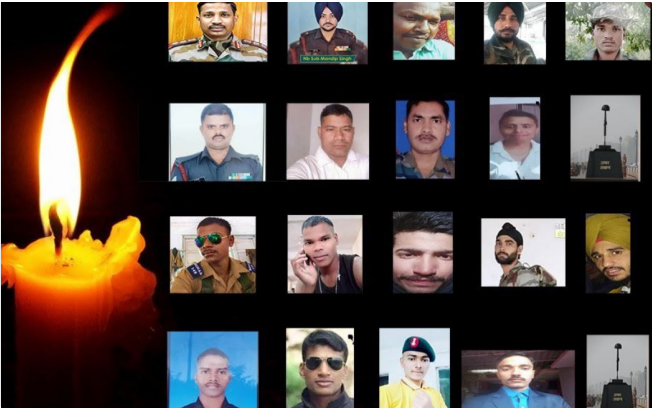
Besides strengthening China’s military muscle, Xi Jinping has initiated unconventional dominance methods by deepening countries’ economic dependence on China. A decade ago, only one of China’s neighbours traded with China more than the US. China has become the largest trading partner for almost all its neighbours and numerous other nations worldwide. However, trade remains the only guise for its economic foray, and actual intrusion comes from so-called “easy” financial assistance. China’s economic engagements in Sri Lanka and Malaysia, ultimately ending up in a debt trap, are suitable examples of the Chinese strategy of hegemony without using military forces. Using a combination of military dominance and economic dependence, China can compel countries to submit to its will.
However, it is essential to note that China’s recent aggressive tendencies in the region and worldwide have not gone unnoticed. The West has become wary of China’s attempts to carve out a space for itself as a global power and has begun to push back its manipulative manoeuvres. The US, under the then-Trump administration, had taken a strong stance against China’s overindulgence in the South China Sea, labelling Chinese apps as national security risks and even criticising China’s handling of the COVID-19 pandemic. In addition to calling out Beijing’s apparent hostile actions, the world also exposes the hypocrisy of China’s subtle tactics in influencing nations’ foreign policy. During the unrest in the US over the rights of people belonging to different races, China allegedly used bots and trolls on Western social media platforms to run a systematic campaign that would augment the division and unrest in the US.
Recognising these covert and overt manipulation factors, the US decided to ban Huawei, China’s premiere mobile technology company. Over the years, the Chinese tech giant, which looked poised to steal the crown away from Samsung as the world’s largest smartphone manufacturer, has been increasingly accused of indulging in shady business practices. It has also been alleged that the company has been stealing its customers’ private data and supplying it to the CCP. Finally, in 2019, the US put its proverbial foot down when it added Huawei and several other Chinese companies to its “Entity List”. This means that these companies and organisations are not allowed to have dealings with any organisation that operates in the US. This ban made Huawei unable to work with companies like Google, Qualcomm, and Intel, thus making its products less desirable.12 The US also advised its allies to implement similar measures. Hence, despite the risk of Chinese retaliation, countries such as New Zealand, Australia, and the UK have taken restrictive measures accordingly.
The US has also taken steps against Chinese social media apps such as TikTok and WeChat. The then US President Donald Trump had termed these apps as “security risks” and signed an executive order on August 6, 2020, stating that if TikTok wanted to continue its operations in the US, it must sell its US operations to an American company. There were security concerns, with the app secretly funnelling private user data to the CCP. Likewise, with WeChat (China’s version of WhatsApp), the Chinese Government is believed to be monitoring the text conversations of the app users and, at times, even censor and ban those who indulge in unflattering discussions about the CCP Government’s affairs. Earlier in 2019, reports accused WeChat of censoring political messages and deactivating people’s accounts if they were caught voicing their approval for the landslide victory of pro-democracy candidates in Hong Kong. WeChat, owned by China’s Tencent, is widely used in the country. Not just native Chinese, the app is also popular among hundreds of Chinese Americans, for whom it is the only means of communicating with relatives back home since WhatsApp is banned in China.
In this report, an attempt has been made to highlight the numerous sectors in the Indian economy and society where China has made deep in-roads through a combination of methods ranging from financial investments as seen in the entertainment industry to spreading propaganda in the socio-political realm through Confucius Institutes & establishment of think-tanks in an attempt to covertly influence essential policy decisions & shape the Indian discourse to suit its interests.
It is no secret, then, that in its desperate attempt to attain supremacy, China is leaving no stone unturned to propagate its false narrative and sow seeds of discord within India’s multicultural democratic framework where, unlike its polity, differences are respected. Opinions are given in voice audio shows ranging from Audiobooks, Stories and Podcasts.
CHINESE INFLUENCE ON THE INDIAN ENTERTAINMENT INDUSTRY
A couple of Indian scholars had come up with a litany of academic papers and film reviews to criticise the film “Haqeeqat” for demonising China and showing the PLA in a negative light. Few critics argued that the film, which was produced in 1964 on the Sino-Indian war of 1962, “leaves no space for grey; good Chinese and bad Indians are simply not to be found – and in this sense, forecloses the possibility of a self-reflective questioning of the ideals of nationalism, war, sacrifice, and bravery.” Several academicians had also termed the movie as a “war film”, one of the first of this genre to be produced in India.
Over the past few years, China has been consistently trying to make inroads into Bollywood for its influence operations through the mechanism of co-productions. To accelerate the entry of Chinese stakeholders to co-produce films in Bollywood, China organised the China-India Film Co-Production Dialogue at the Beijing International Film Festival in 2019 and successfully managed the participation of prominent Indian cinema icons like Shah Rukh Khan and Kabir Khan.
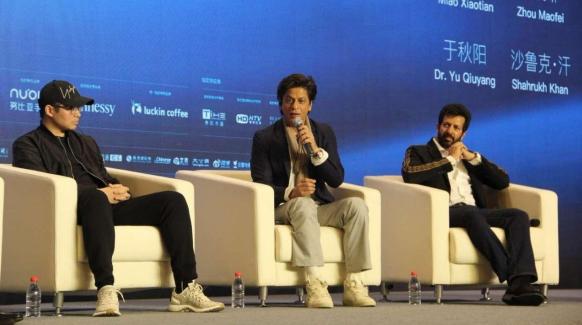
Several Indian filmmakers were invited to the Beijing International Film Festival in 2019, just a year after the regulation of films and media was handed over to the Propaganda Department of the CCP in 2018.16 This was the time Beijing began to push for co-productions in Bollywood. Since then, the Beijing International Film Festival has been managed by the Propaganda Department of the CCP, and the films are selected for display after rigorous scrutiny to ensure that the film festival proves to be a prominent tool for propagating pro-CCP narratives.
A cursory glance at the association of top Indian film industry leaders with the Beijing Film Festival and the co-production initiatives that have been launched reflects the amount of penetration the Propaganda Department of CCP has been able to achieve in Bollywood today. The selection of Shah Rukh Khan’s film “Zero” as the closing film at the 2019 festival seems like a calculated step, as that festival edition aimed to strengthen the propaganda mechanism of the CCP rule, which entered its 70th year. The edition included a barrage of propaganda flicks, including “The Founding of a Republic,” made in honour of the 60th anniversary of CCP rule, as well as similar prominent films like Zhang Yimou’s “Red Sorghum” and HuoJianqi’s “The Postmen in the Mountains”.
As a favourable outcome of the 2019 film festival, filmmakers of both countries entered into an agreement to jointly co-produce three films. This was not new to the industry, where apparently several Indian production houses had already signed co-production agreements with Chinese partners in the preceding years.
The CCP has also formed an industry body, rather than a lobby group, dedicated specifically to the Indian film industry. The association is headed by an Indian lobbyist. In the past, a group named the India-China Film Society was constituted by the CCP’s unit China Film Association (CFA) and the China Federation of Literary and Art Circle (CFLAC) – a unit of the CCP’s supreme body Chinese People’s Political Consultative Conference (CPPCC). This Society was put in place as early as 1949 and has since then been tasked with carrying out Chinese influence operations in academia, literature and films.
Typically, Chinese influence operations in films have been subtle yet systemic. In certain instances, prominent individuals in film regulatory bodies have ensured that Chinese interests are well represented in Bollywood. In one such case, the producers of the film“Rockstar” had to blur a flag that had “Free Tibet” written on it, which was shown in a popular song of the film. The then Central Board of Film Certification (CBFC) team was made to believe through Chinese influence operations that the posters of “Free Tibet” would have hurt the Chinese sentiments and harmed Sino-Indian ties.

Source: YouTube

Through close collaborations with various stakeholders, it is claimed that China has also been setting the narrative of films in Bollywood. For this purpose, China has been endorsing Indian actors and producing fake data on the success of their films in China. In fact, one investigative journalist argues that the Communist Party-run government in China issues false statements of the commercial success of members belonging to a fraternity to create a positive impression about their films. It is further alleged that a prominent Bollywood actor is part of this dissolute caucus. Based on the findings of NT Haslam, the investigative journalist has highlighted the mechanisms deployed by the CCP Government to inflate earnings figures and exaggerate the “successes” of films of a particular Bollywood star.
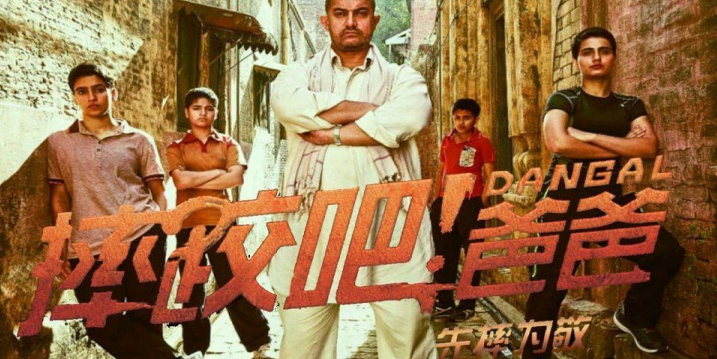
Rs 500 crores | Source: Forbes
Thus, the influence of Chinese money in calling the shots in Bollywood cannot be denied. Recently, Xiaomi led a $25-million investment in Hungama Digital Media Entertainment – an aggregator, developer, distributor and publisher of Bollywood films. The company is also into digital marketing and owns several songs and movie-based apps, each used by millions. Hungama has partnerships with over 700 content creators and offers over 8,000 movies in Hindi, Tamil, Telugu, Malayalam, Bengali, Punjabi, and six other Indian regional languages on its platform. It has around 100 million monthly active consumers who access Hungama across platforms for its music, video and movie streaming services.
Besides cinema, Chinese firms have also taken over all the top music and video platforms in India. Gaana is the largest Indian commercial music streaming service, in which the Chinese internet giant Tencent has invested over $115 million.25 Tencent funded over $110 million to MX Player too – an entertainment app with millions of downloads in India. Similarly, Alibaba group has invested around $2.11 million in Vidooly, which is an online video analytics and marketing company that provides video analytics tools and video marketing services.
Not restricted to the visual medium alone, the Chinese have also begun to venture in the domain of Indian broadcasting. Pocket FM is a social audio platform for Indian languages, where users can find great quality audio shows ranging from Audiobooks, Stories and Podcasts. Tencent has invested around $12-15 million in Pocket FM.
CHINESE INFLUENCE AND ENGAGEMENTS WITH THINK TANKS AND CIVIL SOCIETY
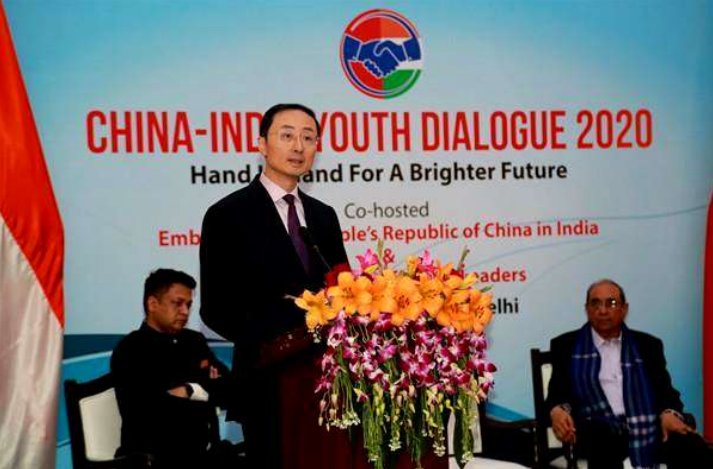
Within the world of academics, one can state with certainty that a prominent university located in the National Capital Region around Delhi is emerging as the bastion of so-called China “experts”. It runs a flagship fellowship that allows for the exchange of visiting scholars between India and China. Under the fellowship, academics, policy experts, and professionals are made to work on China-based topics. They also get access to Chinese diplomats and frequently visit China. The University has been granting this fellowship to numerous individuals, including academicians, research scholars and journalists. The topics allocated to researchers clearly raise suspicions over the objectivity and the objectives of the research conducted on China-related.
A new organisation, which calls itself a “Foundation”, based out of Delhi, is working on mission mode to create sentiments favourable to China among Indians and is discharging duties similar to that of the Chinese Embassy. Though it claims to work as “a mission to increase mutual understanding between the people of India and China”, its functions resemble that of the mouthpiece of the CCP in India, which is obvious through an analysis of its statements and events. The organisation’s advisors include a journalist, an academician, and a former diplomat. This organisation is aggressively running a programme called “China Study Centres” to promote pro-China sentiments in India through which it helps set up these Centres in top Indian universities.” The organisation, which was working in full swing, reportedly suspended its website to save itself from the scrutiny of Government agencies and public backlash amidst the 2020 Indo-China standoff at Ladakh. The organisation’s website is now redirected to what is called the “Asian Century Foundation”, created in 2020.
The founder of the above organisation has also helped establish the visiting scholars’ fellowship at the said National Capital Region-based University, where he happens to be the Chairman.’ He also runs EdTech and Policy startups whose investments may possibly need to be examined by Government agencies for reported Chinese funding. China has been constantly rewarding him, and to help build his image, he was placed 15″ on the 2014 Hurun India Philanthropy List, a dubious ranking of the most generous individuals in India accorded by the China-based Hurun Research Institute.
Another major organisation that has strong connections with China is a youth-based group that claims itself to be an association of “young leaders”. Members of the organisation are frequent visitors to China and the Chinese Embassy. Lately, it has organised a China-India Youth Dialogue at the Embassy of China in New Delhi. Those observing the outfit would be keen to know if the Chinese Embassy in India is the financer and the brain behind this initiative. The events of this organisation are filled with flattery for the Chinese Ambassador, who is also a frequent guest to the setup. The organisation runs many youth exchange programmes and takes Indian delegations to China and its universities. They are received warmly everywhere across the country. A self-acclaimed “youth leader”, little known otherwise, is the Chairman of this organisation, rewarded handsomely for his efforts in numerous ways, including trips to the country in mention. He is an expert in authoring China-appeasing articles across Indian media platforms.

Source: Chinese Embassy in India
Such is the level of Chinese penetration in the Indian intellectual space. The said organization could also manage to have an individual related to a former Prime Minister of India on board. Strengthening their bonds securely, the “youth organization” went on to sign an MoU (Memorandum of Understanding) with the All-China Youth Federation (ACYF) — the youth wing of the CCP, dedicated to carrying out subversive operations worldwide. In his adulation, Xi Jinping has described the ACYF as an “integral part of CCP’s youth work”.This clearly reflects the amount of leverage the unit has in operating and hiding itself from the eyes of intelligence agencies.
There is also a Lutyens think-tank dedicated to Chinese studies, which has tried to project itself as a “neutral” research organisation, though in reality, it is aggressively trying to build pro-China sentiments in India. Reportedly, through questionable studies and analysis, it tries to portray Communist China in a good light and has never raised concerns over Beijing’s expansionist agenda or human rights abuses — not even its incursions into Indian territory! The organisation has been founded by a prominent pro-China voice in the Indian academia. Besides, a couple of prominent former diplomats are associated with the organisation. The think-tank also “recommends” Indian students for post-doctoral studies in China through a tie-up with the Harvard-Yenching Institute.
Further, a prestigious Indian think-tank known for its powerful connections in diplomatic circles reportedly received a donation worth Rs 1.76 crore from the Chinese Government. It received Rs 1.26 crore in 2016 and Rs 50 lakh in 2017. Additionally, the think-tank received three grants worth nearly Rs 1.26 crore from the Chinese Consulate in Kolkata in 2016 in three tranches — Rs 7.7 lakh on April 29, 2016; Rs 11.55 lakh on November 4, 2016; and Rs 1.07 crore on December 31, 2016. China also facilitated the think-tank with another grant of Rs 50 lakh through other channels in December 2017. This well-funded think-tank is believed to enjoy a strong rapport in the Indian bureaucratic network and numerous diplomats across the globe.
Along with such prominent think-tanks, China has also been funding policy and advocacy organisations at the local level. Recently, officials of a non-profit organisation based out of the historic city of Rajasthan made a visit to China. The leaders of the non-profit group, who claim to work on human rights and rural development, were all praise for China’s development and its ideals. Comparing India with China, they also used the opportunity to attack the Indian Government by calling it “Hindu nationalist’ for aggressive posturing and entering “Chinese” territory after “murdering democracy in Kashmir by abrogating Article 370”. Besides making such absurd allegations, they also kept mum about the outright human rights violations by the CCP, including the Uyghur genocide in East Turkestan; suppression of rights of the Tibetans, Hong Kongers and Mongolians; organ harvesting of Falun Gong practitioners; persecution of dissidents; and the countless inhumane acts that typically characterise CCP in the current times. The Rajasthan-based Non-governmental organisations (NGO) are just an example, as the list of such organizations working as units of Chinese influence operations tends to go on and on.
In addition to peddling propaganda on COVID-19 through the Indian media, the Chinese Government also efficiently used Indian think-tanks to aid them. The Chinese Government overtly and covertly organised several events in India to present China in good light during the pandemic. One such example is of Chinese Consulate in Mumbai organising an event titled “post-COVID-19 city governance”, in partnership with a Mumbaibased organisation that claims to be working in the field of international relations. The respective speeches of the Indian speakers in the event were full of lofty praises and appeasements for the Chinese Government. Interestingly, instead of questioning the CCP for the COVID-19 crisis and maintaining secrecy around it, the speakers went on to describe the achievements of China to contain it and the path of “development” that it was rapidly advancing towards.
Besides attempting to influence through think-tanks, China has also deployed Chinese “intellectuals”, “academicians” and floated organisations to attain its objectives. Such is the effort at influencing policy-making that to pressurise the Indian Government to rethink its decision on not joining the Belt and Road Initiative (BRI), China floated the Indo-China Economic and Cultural Council (ICECC) to build an outreach campaign to influence Indian opinion leaders. The offices of ICECC were in Beijing and New Delhi — where it is registered as a “Trust”. China also managed to have several Indian political and business leaders as the ICECC members.
ICECC also runs a magazine titled “India-China Chronicle”, covering trade and bilateral relationship between the countries. A couple of readers seem to have highlighted that the March-April 2019 edition of the magazine carried the cover story “BRI Boycott: India’s Foreign Policy Risk?”, with a clear pro-China bias. Unlike other editions of the magazine, the link of that specific edition of March-April 2019 has been now disabled.
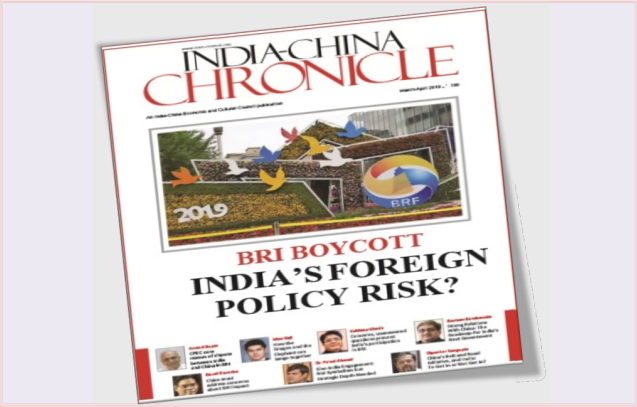
Interestingly, the organisational documents of ICECC revealed that the addresses of the respective Beijing and New Delhi offices were same as that of another Chinese organisation, the Bureau of Research on Industry & Economic Fundamentals (BRIEF), which is also meant for covert operations in India.
The central figure related to both these organisations (BRIEF and ICECC) in India is Mohammad Sagib, who is the CEO of BRIEF and Secretary-General of ICECC. Saqib is remarkably close to the Chinese Embassy in Delhi and is in regular touch with its officials. During calls for economic decoupling with China, he strongly/ advocated that “blanket high tariff to discourage Chinese imports won’t be good for India.”
It is imperative to mention that BRIEF was registered in India in 2008 and claimed to be a market research and consultation think-tank, working to promote trade among India, Pakistan and China. However, diverging from its stated objectives, the organisation soon began to work on sensitive matters like Kashmir and the Line of Control (LoC). BRIEF also collaborated with the international organisation, Conciliation Resources to “support the confidence-building measures for across LoC trade between the two sides of Kashmir.”
Further, the Chinese People’s Association of Friendship (CPAF) with Foreign Countries is another infamous front of the CCP, used to further its agenda abroad and strengthen its soft power through influence operations. The outfit is believed to have established a significantly strong network in India. CPAF is a unit of the United Front Works Division of the CCP, working to influence the opinion of both national and local level leaders of foreign countries.
The association has also been awarding Indian citizens, who perceivably have been “contributing to the Sino-Indian friendship”. The list of awardees includes a prominent leader of an Indian Communist political party, Chancellor of a University and founder of the first Confucius Institute in India, besides several academicians and other prominent personalities.
GROWING NEXUS BETWEEN THE CHINESE EMBASSY AND INDIAN ACADEMIA
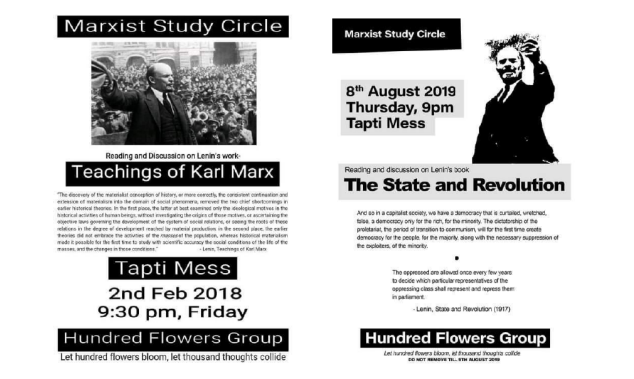
Among the new-age businesses, the Indian EdTech industry is a sector that has been dominated by Chinese firms since its early days. Chinese venture capitalists were among the first to invest in India’s EdTech, knowing its vast potential to influence the youth.
Tencent has been the angel investor in BYJU’s and Doubtnut, with $50 million and $15 million worth of investments, respectively. Whereas another EdTech platform, Vedantu, recently got invested with $12.5 million primarily by Chinese venture capital firm Legend Capital, with participation from Omidyar’s Ohana Holdings LLC. Hence, it can be stated with certainty that the top three EdTech platforms in India are dominantly owned by Chinese investors.
It is also noteworthy to state that China-based centres are rapidly coming up and have been established in dozens of Indian institutions. Even the top public institutions may be seen promoting pro-China sentiments among Indian students. A prominent public management university located in the North-East of India runs a popular course – Pos Graduate Program for Executives (Managing Business in India and China) – and sends students to Fudan University School of Management (FUSM), Shanghai, and Ocean University of China, Qingdao. The course structure is designed to reflect China in a good light, and events organised by this program are full of praise for China and its development model. The students enrolled in this course are readily employed by Chinese companies as part of their outreach strategy.
Another major centre promoting pro-China sentiments in India is the Centre for India-China Studies at a prominent NCR-based University, established by a leading business house. The centre runs numerous cultural exchange programmes with China and organizes events on Chinese culture and policy. It is the only Indian think-tank on Chinese Studies led by a Chinese. The Director of the centre is a Chinese scholar Wenjuan Zhang, who has worked with the CCP Government and is remarkably close to the Chinese Embassy in India.
The Chinese Ambassador to India makes frequent visits to the Centre. Dr. Bao Jiquing, the wife of the Chinese Ambassador to India, also delivered a “distinguished public lecture” at the University. Professors of the Centre have also reportedly participated in the “Short-Term Visiting Programme to China for the study of Belt and Road Initiative”, a Chinese propaganda event to cultivate a pro-BRI atmosphere.”
Besides Wenjuan Zhang, another professor at the centre, Huang Yinghong is suspected of pushing Chinese interests through the academia in India. Yinghong is believed to be propagating pro-BRI and Silk Road narratives in India. Yinghong once even argued that though the BRI worries India, it also “makes India hope to take this opportunity to strengthen infrastructure construction, accelerate economic development, and gradually shift its strategy to a pattern of equal emphasis on east and west.
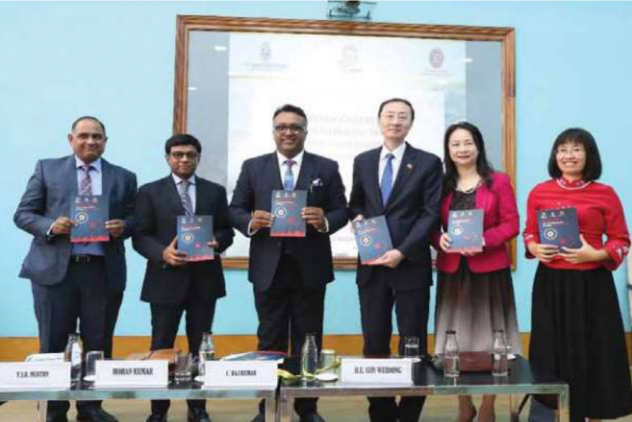
Sonipat | Source: 5th anniversary celebrations handout
A similar centre promoting pro-China sentiments is the China Studies Centre at the Indian Institute of Technology (IIT) located in South India. It has been organising several exchange programmes, which have mostly been one-way, taking Indian students to China to show them its culture and educational institutions. In order to use cultural influence as a soft power to infuse pro-China sentiments in the students, the Centre also celebrates Chinese festivals.” A professor associated with a pro-China think-tank based out of Delhi is one of the prominent Board members of this Centre. The Centre is run by an Assistant Professor of Humanities at the said IIT.
In recent times, several pro-China study circles have propped up, aimed at radicalising the students’ network in different colleges. These study circles are primarily focused on romanticising the notions of unrest and dissent through the thoughts of Mao and Lenin, while subtly influencing impressionable minds to profess and speak up against their own state.
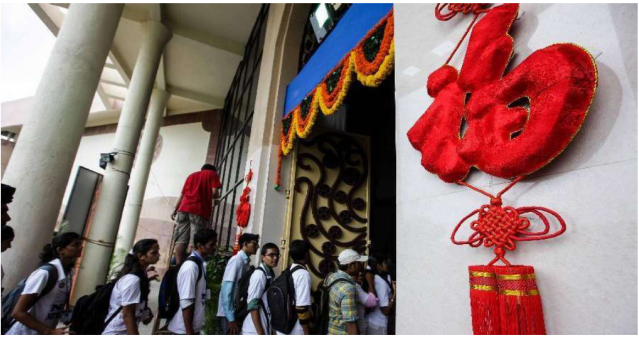
With an expanding clout internationally, China is seen using its state-supported social foundation, the “Confucius Institute”, as an apparatus to expand its public influence operations abroad. Established in 2004, its staff is not deployed by colleges, so they are not secured by codes of scholarly conduct and are easily amenable to outside influences. Their courses, in a structured form of propaganda, deliberately ignore Beijing’s complete disregard of basic liberties and acts of dictatorship; for example — the Tiananmen Square massacre is conveniently overlooked; Taiwan and Tibet are depicted as undisputed regions, and the abuse of Uyghurs and Falun Gong is conspicuously absent. The students, then, get a whitewashed variant of China. In terms of social relations, the Confucius Institutes advance Communist coalition culture as a way of being vis-a-vis the “customary Chinese culture”. These institutes have come under the scanner in countries like the US and Australia, and several Governments have already launched crackdowns for their involvement in carrying out covert influence operations.
In line with this global trend, the Indian government has also recently decided to bring the functioning of such institutes under the scanner. According to reports, the Indian chapters of the Confucius Institute and Confucius Classrooms in seven colleges and universities are being monitored, including two chapters of the institute associated with the Mumbai University and Kolkata’s School of Chinese Language respectively, which have drawn particular attention.
China also offers fellowships to Indian students to take up studies in China. Schwarzman Scholarship, Confucius China Studies Program (CCSP) Fellowship and UNESCO/People’s Republic of China (The Great Wall) Co-Sponsored Fellowships Programme are some of the major fellowships through which dozens of Indian students go to China to take up studies and return with a sense of affinity towards that country. The fellows selected under these schemes are generally young scholars who tend to have a good hold over Lutyens and enjoy proximity in power circles.
Even in the Military sector, the CCP has sent around 2,500 military scientists from the People’s Liberation Army (PLA) to different countries to strengthen PLA’s technological capabilities by taking advantage of knowledge available in the Civilian sectors. These military scientists are reportedly working on talent hunt programmes, academic collaborations, joint research initiatives in different countries to rope in talent, particularly dual use, for the benefit of China, besides carrying out a wide array of espionage activities.
This initiative was launched under the aegis of the State Administration of Science, Technology and Industry for National Defence (SASTIND) and led by PLA’’s National University of Defence Technology, with affiliations to at least 61 civilian universities in China. These Universities (15 of them) have been exposed for indulging in espionage activities for China.
Noticeably, the Chinese Consulate in Kolkata has also been actively carrying out activities that seek to further Chinese influence in the region. For example, the Consulate office was working to set up Confucius classrooms in the city and started a series of events under the banner of “Chini Adda” to accelerate its outreach and expand the network. The office also apparently enjoys a good network in a number of prominent educational institutions in West Bengal. The Consulate has also set up a Chinese language school, which is believed to be working towards promoting pro-China sentiments.
It is a matter of concern that China till now has been successfully able to advance its narrative-building project in India with a Memorandum of Understanding being signed by Chinese Universities with at least seven Indian educational institutes for “collaborations” at various levels, including exchange programmes, joint research projects, technological collaborations, etc., potentially threatening the national security apparatus of India.
For its part, the CCP is extremely organised in carrying out influence operations in various countries, particularly those in its immediate neighbourhood. As part of the grand project of covertly influencing the policies in other countries, the CCP even launched a massive talent hunt programme in more than 600 centres across the world. Using technologies like artificial Intelligence (Al), Machine Learning, and Big Data, these centres have built comprehensive databases of top scientists and researchers for a more targeted recruitment. From the point of view of national security, it would be important for India to find out the details of Indians included in such databases and prevent the Indian talent from falling prey to Chinese covert operations under the guise of harmless recruitme
CHINESE USAGE OF INDIAN MEDIA AS A STEPPING STONE
In continuation of the propaganda tactics mentioned earlier, China also uses Indian media and media people to advance its influence operations in India. One such example is the detained journalist Rajeev Sharma, who is facing allegations of spying for China. If one goes through the articles he authored, one can quickly ascertain that he has been a long-time contributor to Chinese influence operations in India to the extent of even advocating that India hand over His Holiness the Dalai Lama to China for the attainment of regional peace. In an opinion piece published in The Diplomat, titled “The Dalai Lama Thorn?”, Sharma argued that the Dalai Lama was a significant factor behind the Chinese aggression and professed the need for India to hand him over to them. Similarly, in another piece published on an Indian media portal, “Why the Dalai Lama is becoming the biggest bone of contention between India and China”, Sharma went to the extent of terming the Dalai Lama a more significant issue than Masood Azhar’s designation as a terrorist at the United Nations, India’s entry into the Nuclear Suppliers Group (NSG), or the stapled visa issued to citizens of Arunachal Pradesh. These are conscious efforts to distract the public attention and to orient the narrative towards issues that may not seem significant at that moment.

National | Source: freepressjournal.in
Just before getting arrested, Sharma even published a piece in the “Global Times” on 9th July 2020, titled “A rapprochement road map for Beijing and New Delhi benefits both countries”, wherein he opined that the contention between India and China at the LAC “could wreck their economy and many precious things if the situation is not amicably eased in double-quick time”. In a few articles published in the Chinese news platform and, more specifically, CCP’s main propaganda arm, Global Times, Rajeev Sharma’s name has been mentioned as the “Global Times correspondent based in New Delhi”.Touching upon India’s strategic interests and favouring Chinese expansionism in the Indo-Pacific, Sharma, in his piece published on 14th November 2017, tried to prove that the Quad initiative shall do more harm to India than good by putting forward five foolish reasons why India should not join the Quad and questioned the functioning and success of the alliance. Crossing limits, in an article titled “Doklam standoff: Why India should reconsider its stand on OBOR”, published on 19th July 2017, he urged India to accept the Belt and Road Initiative (BRI) and “give some kind of concession to Beijing” and argued that “India’s outright rejection of the OBOR has upset China to no end.
Along with print media, China has also made inroads into Indian wire services and is said to have been influencing them for a long time. After the Galwan clash, the Press Trust of India (PTI) conducted an interview with Chinese Ambassador Sun Weidong, in which he squarely blamed India for the LAC conflict and the violent face-off clash in the Galwan valley, leading to the martyrdom of 20 Indian soldiers. The questions seemed to be scripted in favour of the Chinese Ambassador. A cropped interview version was also posted on the Chinese Embassy website. Chinese proxies and pro-China Social Media handles tweeted and endorsed the same cropped clip. After this, the PTI faced a backlash for contributing to the Chinese misinformation campaign. Prasar Bharati, the most significant contributor to the PTI, decided to review the continuation of their relationship in the wake of “recent news reports”. Prasar Bharati also expressed concerns that such reports were detrimental to India’s national interest and territorial integrity.
China has invested hugely in India’s top three news aggregators/apps. An investment led by ByteDance pumped in $25 million in Dailyhunt – a news content platform in India’s major regional languages. It is headed jointly by Virendra Gupta, Umang Bedi, and Bapu Kota. Dailyhunt has more than 330 million monthly active users.
The Indian Army has banned it for its soldiers for suspicions of being covertly involved in data mining. Moreover, Tencent leads a $50 million investment in NewsDog, an app vying to be India’s top news aggregation app. NewsDog is owned by Hong Kong-based firm Hacker Interstellar. It had at least 100 million users in India. UC News is another news outlet of UCWeb, which is a business within Alibaba Mobile Business Group. At the time of getting banned, it had more than 130 million monthly active users in India.
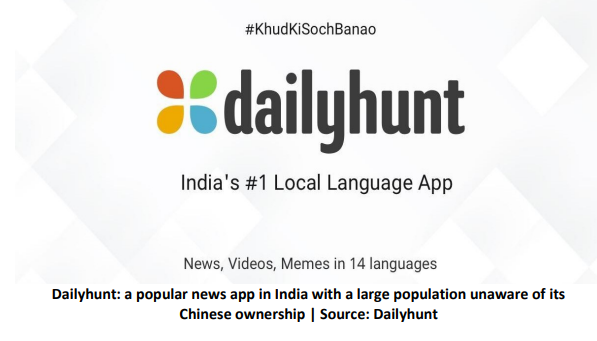
The Alibaba-owned UCWeb was planning to enter the e-commerce business in India by building a recommendation engine to throw up product listings alongside the company’s existing offerings. A partnership was in the pipeline with e-commerce firms such as Flipkart and Paytm Mall for this service to enable its formal launch.
These China-owned news platforms’ focus and reach in local Indian languages, besides Hindi and English, can become the greatest threat to India’s internal stability and peace. They are serving content in regional Indian languages, including Malayalam, Marathi, Telugu, Gujarati, Bengali, Kannada, Tamil, Punjabi, Odia, Urdu, Bhojpuri, Assamese, and even Kashmiri. Moreover, the other China-backed news aggregator, NewsDog, has plans to open its offices in every state of the country in an apparent move to prepare the effective ground for a significant influence operation at the local level.
China’s aspiration to influence Indians at the grassroots through local languages is not restricted to news apps that create/aggregate content in regional languages alone. China also uses broadcast media to push the pro-China narrative in India. The Tamil broadcast of “China Radio International” (CRI) is working sustainably to propagate the Chinese narrative amongst India’s Tamil-speaking population actively. Brazenly violating Indian interests, the broadcast criticised the Indian Army for its activities on the Line of Actual Control (LAC) and argued that it was aimed at taking military control of the standoff area. The Tamil broadcasts of CRI have also been promoting the narrative that contrary to the “economic slowdown” in India, China is headed towards accelerated growth. Going a step further, it even attacked the sovereignty of India by not recognising the Union territory of Ladakh as its integral part.
The radio channel has also established CRI Listeners’ Clubs in several parts of Tamil Nadu to ensure it makes inroads in the remotest areas of the state.
Interestingly, in the media domain, from 2016 onwards, China’s Foreign Ministry’s Chinese Public Diplomacy Association (CPDA), an organisation set up in 2012 to propagate the Chinese narrative, has been running a journalism fellowship for journalists from India, Pakistan, Nepal and the South-East Asian nations. Former Foreign Minister Li Zhaoxing is its president. Among the Indian media organisations that have participated in the programme are the Indo-Asian News Service (IANS) under its previous management, Jansatta and The Indian Express. The most significant number of journalists joining the fellowship is from The Indian Express.
These journalists send China-favoring news and reportage to their respective organisations based in India. The news articles get published as reports from their correspondents based in Beijing, without mentioning that these reporters are on a Chinese Government-sponsored fellowship. They have been given red carpet treatment with apartments in one of Beijing’s plush residences, the Jianguomenwai Diplomatic Compound, where a two-bedroom apartment costs 22,000 Yuan (Rs 2.5 lakh approx.). They are also given a monthly stipend of 6,000 Yuan (Rs 68,000 approx.) and free tours twice every month to different Chinese provinces. To familiarise them with the Chinese language and profess the Ocal culture positively, language classes are undertaken, and at the end of the program, they are given degrees in international relations from a Chinese university.
Apart from luxurious residences, the journalists, on their arrival to China, are also gifted iPhones with their iCloud data stored in Chinese servers and continuously monitored by Chinese Government officials. In line with its propaganda endeavours, the journalists are also exposed to a mobile app called “Study the Powerful Country”, which was initially meant to brainwash foreigners about the policies of Chinese President Xi Jinping and his ideology.
There are examples where the post-fellowship writings of Indian journalists have not only favoured China but have also opposed the decision to ban Chinese apps by the Indian Government. One such Indian journalist has also been associated with the Delhi-based “Foundation”, which was set up by the “philanthropist” who is working to set up “China Study Centres” across India. She was part of the 2019 fellowship cohort.
Talking to the Straits Times, a journalist of Indian Express, who went for the fellowship in 2017, praised China and said he was “never pulled aside or frozen out” despite reporting extensively on the recent Doklam border stand-off between China and India. The Indian Express has also claimed that it did not see any conflict of interest in its journalists living in China and writing pro-China stories.
It is also believed that the Chinese media fellowship programme selects several Pakistani journalists with close connections to Pakistani spy agencies. For example, Bilal Ahmed Sabri, a Pakistani journalist close to the agencies, was also selected for the 2019 cohort of the fellowship. Interestingly, he had greater access to Chinese leaders and government offices than other fellows in his cohort. In return, he also extensively worked to propagate the Chinese narrative in Pakistan that the CPEC would be a game changer for the country.
Besides, China has also been pocketing leading Indian dailies by direct funding and paying for pro-China stories. For example, “Hindustan Times”, in its edition of 13th December 2019, carried a full-page supplement with two articles by a Chinese national, Yuan Shenggao, under the sponsorship of China Watch Daily. The articles were titled “Decades of Progress Highlighted” and “Unparalleled change experienced within a space of a generation.” The propaganda article presented China as the Messiah of Tibet and argued about development, economic prosperity, social stability, ethnic unity and religious freedom in Tibet since the 1950s under the Communist regime.
The newspaper seems to be a favourite pick of the CCP, as even in 2017, the 3rd November edition of the national daily carried a similar supplement under the head of “China Watch”. Unfortunately, no regulation could keep a check on such CCP influence operations through Indian media outlets.
As a regular feature, the edition of the “Hindustan Times” on 30th October 2020 too, carried a four-page supplement under the title “China Watch”, sponsored by the Chinese Government projecting its “emancipator” achievements in Tibet and its “development” initiatives for the welfare of Tibetans. The supplement carried several propaganda pieces highlighting China’s success in ecology, housing, job creation, and economic development.
Given the critical timing of the supplement, the reaction of social media users was not very encouraging for the “Hindustan Times”, as they found it inappropriate due to the continued standoff at the LAC and the Chinese aggression in the Galwan Valley.
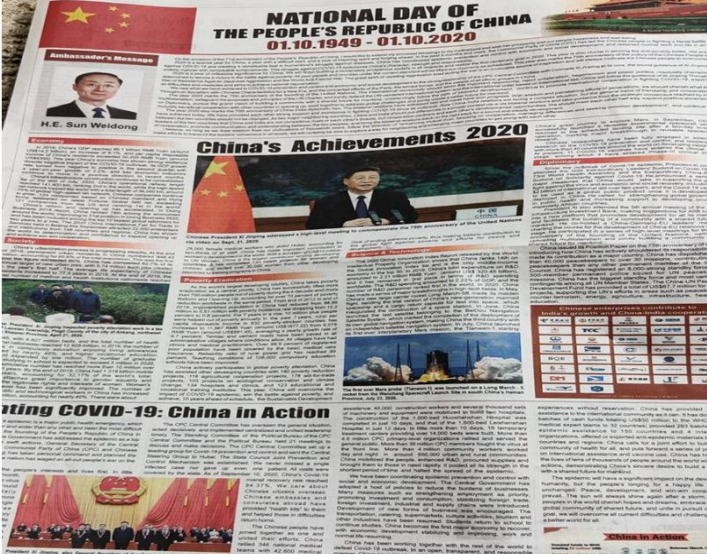
The same newspaper had, on 5th November 2019, published an op-ed by the Chinese Ambassador to India, Sun Weidong, wherein he tried to threaten India on its stand on Tibet, stating, “It (China) hopes and believes that India, as a responsible major country, will stick to its position, honour its commitments, resist interference on Tibet-related issues and promote the healthy and stable development of China-India relations.”
Taking all these factors into account, recently, the Union Ministry of Home Affairs has taken cognisance and launched an inquiry over the desperate propagation of the narrative by “Hindustan Times”.
It is a known fact that the “China Watch” supplement has a recorded dark history. According to revelations by Western media outlets, CCP-controlled “China Daily” has paid more than $4.6 million to “The Washington Post” and nearly $6 million to “The Wall Street Journal” since November 2016. China has also paid $2,40,000 to Foreign Policy, $50,000 to the “New York Times”, $34,600 to “The Des Moines Register” and $76,000 to “CQ-Roll Call” in the past four years. The news platform said, “Both newspapers have published paid supplements that China Daily produces, called “China Watch.” The inserts are designed to look like real news articles, though they often contain a pro-Beijing spin on contemporary news events.”
Additionally, the CCP also spends billions of dollars on overseas propaganda. Some newspapers help lubricate the CCP’s propaganda mechanism by publishing its full-page advertisements/advertorials without clearly marking them as advertisements or advertorials. Any advertisement/advertorial about China deceptively looks like the newspaper’s own full-page coverage.
In India, not just “Hindustan Times”, but even “The Indian Express” published a supplement of “Tibet Today” showering praises on China for its “development initiatives” in the region in July 2016, thereby reflecting this historical trend of penetrating influence in the media.
This was very apparent amidst the calls for the boycott of Chinese businesses against the backdrop of the LAC standoff and COVID-19 crisis when numerous articles began emerging across Indian news platforms recounting the benefits of Chinese businesses in India, showing them to be having an upper edge over their Indian counterparts. In a similar article, a well-famed online news portal dedicated to business news tried to highlight the idea that companies are not delinking business with China. They are only talking about adopting a “China+1” strategy to diversify supply chains to manage their price and supply volatilities.
During the social movement of boycotting Chinese products against the backdrop of the recent standoff at the LAC, three journalists of a leading magazine published an article questioning the boycott campaign and even arguing the whole exercise was “unrealistic” at the global level with its multiple fallouts for India. One of these journalists penned another article later, trying to create a war hysteria in India and highlight China’s boosted morale.
The title of the article mentioned the speech Xi Jinping gave to the PLA soldiers in May 2020 to motivate and energise them for the challenges ahead. The article claimed that the speech was a big boost to the confidence and morale of China’s commanders on the Line of Actual Control in the Ladakh region, which was not the need of the hour for India.
Further, another prominent newspaper of India carried a news article under the “Explained” section to prove that the China trade ban would hurt India more. The author explained the losses India would have to face by taking such harsh measures, thus pushing for the continuance of Indo-China trade.

figure out whether it is an editorial or paid advertorial| Source: The Hindu
Similarly, an emerging online portal led by a former TV journalist carried a story arguing that though many countries have blocked Huawei, India cannot afford to ban it. The story tried to push for Huawei’s entry into India’s 5G by claiming it to be a prerequisite for the development of India’s telecom story. It is amazing how the article portrays countless benefits of Huawei 5G for India. Interestingly, the article was not aimed at pushing for the specific technology of 5G but rather at the business development of a specific company —Huawei!
Also, a left-leaning news website in India, started by a foreigner, vouched to influence the decision to ban the app ban of the Indian government by exploiting emotions and projecting the “liberating” nature of TikTok in its articles. In one such reference, it termed TikTok to be the Messiah of Indians by terming it a “safe haven for artistes”, “voices on India’s margins”, and so on & so forth.’® It argued that TikTok is a platform for marginalised people from rural India and those who do not come from rich families, with the author being optimistic that there can be some settlement between the company and the Indian Government.
As a counter, it can be said that Indian apps, as alternatives to the banned Chinese apps, were quick to gain momentum in the market. To retard the pace of growth and penetration of Indian apps, another Left-leaning website now ran a story projecting Indian apps to be inferior to the Chinese ones and argued that Indian apps have a long way to go to catch up with TikTok’s popularity. The article was full of praise for Chinese apps such as TikTok and Bigo, and further questioned the Indian Government’s move to ban them.
Going beyond diplomatic limits, China recently also tried to threaten free and independent media in India regarding coverage of Taiwan National Day and providing space and time to Taiwanese leaders. India Today TV news channel aired an interview of the Taiwanese Foreign Minister Joseph Wu before the Taiwan National Day. The broadcast of the interview led to displeasure of the Chinese Embassy in New Delhi, which issued a statement to caution the channel.’® Ji Rong, Press Counsellor at the Chinese Embassy, came up with a public statement that the interview of the “so-called Taiwan Foreign Minister” and use of the platform for Taiwan DPP authority’s separatist activities was “disregarding the Indian Government’s long-standing position”.
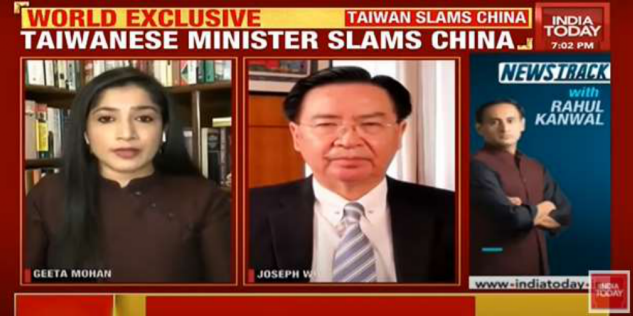
Source: YouTube
Similarly, another prominent English language TV channel WION, aired a few news pieces and provided space for Taiwan related content on its news portal, besides producing a special programme dedicated to Taiwan National Day titled “The Double Tenth Day: Celebrating Republic of China Taiwan’s 109″ National Day” in collaboration with Taiwan’s Representative Office in New Delhi! Similarly, two prominent newspapers – The “Indian Express” and “The Statesman” carried full page advertisements on Taiwan National Day. Baffled over coverage of Taiwanese leaders and Taiwan National Day, the Chinese
The Embassy in India issued a press release on 7″ October 2020 for media organisations and journalists cautioning them not to provide time or space to commemorating Taiwan’s National Day.’? The press release said, “Regarding the so-called forthcoming “National Day of Taiwan”, the Chinese Embassy in India would like to remind our media friends that there is only one China in the world, and the Government of the People’s Republic of China is the sole legitimate Government representing the whole of China. We hope Indian media can stick to the Indian Government’s position on the Taiwan question and do not violate the One-China principle.”
China has been far too successful in having influenced the reputed media houses in India, which now go beyond the principles of journalism and engage in unfounded propaganda. Recently, a Left-leaning national newspaper, which has been consistently propagating pro-Chinese sentiments, was publicly rebuked for peddling fake and twisted news to satiate its own motives of bringing India down before the global community. This happened while the Danish Prime Minister Mette Frederiksen and Prime Minister Modi recently held a virtual summit to elevate the bilateral relations to a Green Strategic Partnership, and “The Hindu” chose to twist the meeting by claiming that the Danish PM expressed “deep concern” over India’s Coronavirus situation. Ambassador of Denmark to India Freddy Svane hit back, as he retweeted the article and said, “Sorry — this is not true. Twisted News”. This was an open statement questioning the credibility of “The Hindu”.
No wonder China’s propaganda plan to project itself as the global peacekeeper, amidst the ongoing aggressions on multiple fronts, was ardently advocated through the said newspaper.
However, when “The Hindu” published an article by Dr. Chen Shih-Chung, Taiwanese Minister of Health and Welfare, on how the country contained Coronavirus successfully despite its geographical proximity and trade relations with China, the Chinese embassy did not hesitate to caution this newspaper despite the fact that it has largely been friendly to them. The Chinese embassy in India had earlier warned the newspaper to fall in line with CCP-propounded values and principles, such as the much-touted “One-China Policy”, which the global community is increasingly taking steps to dump flamboyantly. In the article on Taiwan, the Taiwanese health minister had openly advocated for Taiwan’s participation in the World Health Organisation. This particularly did not go down well with China, which instructed the newspaper that it has been favouring otherwise to strictly adhere to the “OneChina Policy” and not give a platform to Taiwan’s independence warriors.
Amongst the plethora of issues between India and China, in a recent development, India walked out of the RCEP (Regional Comprehensive Economic Partnership) after attending 28 of the 31 rounds of talks, when it learnt that the RCEP was a one-way deal, with nothing to gain for any other player apart from China. If agreed upon, Indian markets would have been flooded by the cheap and sub-standard Chinese goods, making it a dumping ground for China’s low-grade products. This stand of the Indian Government was supported unanimously by all the political parties representing the will of the people. This step by India was indeed a means to safeguard its millions of small traders and businesses
CHINESE PROPAGANDA AND DISINFORMATION CAMPAIGNS OVER SOCIAL
MEDIA
The dominance of the Chinese in social media is reflective in the investments they have been making in various home-grown apps. For instance, companies such as Xiaomi and ShunWei Capital have invested more than $18 million in the social networking app ShareChat and Tencent has put in $150 million in the Hike Messenger app.
Moreover, there is a CCP-backed band of internet trolls known as “50 Cent Party” or “50 Cent Army” that work towards building pro-China narratives. In Chinese, the term 50 Cent Party/Army is used to describe the internet observers (Chinese), who are specifically recruited by specialists to generate favourable sentiments towards the CCP. This came into being during the initial stages of the Internet’s rollout to enable the public to participate in narrative building in China. The name comes from the claim that reporters are supposed to be paid 0.50 renminbi for each post, however, some hypothesise that they are presumably not paid anything for the posts, rather are expected to do these tasks as part of their official Party obligations.” They make positive remarks or write articles on well-known Chinese web-based media networks that have multiple obligations right from wrecking conversations that are detrimental to the interests of the Communist Party, propagating stories that serve the administration’s cause, to making belittling remarks and snooping on political adversaries of the Chinese establishment, both homegrown and abroad.
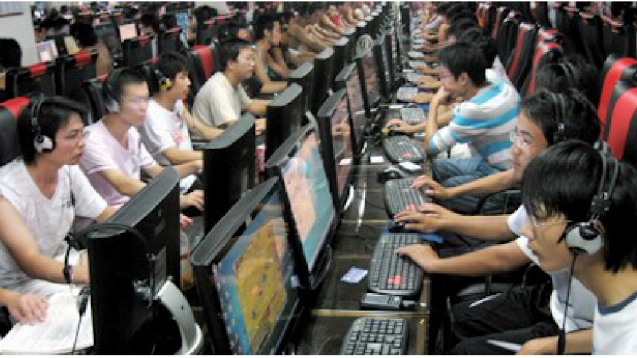
Source: Sri Lanka Guardian dated December 11, 2011
Among other social media apps, Grindr is a hook-up app used by the LGBTQI community and hugely popular in India. It was acquired by a Chinese firm Kunlun in 2016 with a value of $245 million.’ Dating apps, in general, have the highest success rate in terms of interpersonal meetings between unknown individuals. This brings with it the possibility of exposing extremely personal data to the outside world at the risk of being blackmailed at times. Thus, espionage agencies have leveraged such platforms where blackmails are used as tools to elicit favours. As is known, the KGB used it effectively during the Cold War. No doubt, the user data available with the owners, if breached, makes the users vulnerable to blackmail. The US Government has therefore raised concerns about the app and has termed it a national security risk. It has ordered the Chinese owner to divest the majority stake.
Even in India, many of these apps with Chinese funding have been banned owing to national security concerns. As a consequence of the ban on apps, an army of trolls, some of them masquerading as journalists with pro-China sentiments attacked the Indian Government and questioned the impact of such steps, besides portraying China as being the all-powerful neighbour.

handles that aggressively push pro-Chinese propaganda in India | Source: Twitter
An analysis of tweets from a couple of Twitter handles with a significant number of followers, reveals that a number of Indian “influencers” and “defence experts” might be tacitly working to boost the Chinese propaganda in India, especially during the time of aggression by China. Regarding one such Twitter handle, analysts have found, “the upshot of this account’s tweets is that PLA is far superior in capabilities, as it has excelled in algorithm warfare. In contrast, the Indian Army continues with Second World War tactics.” Further, provoking the Army veterans, the said Twitter account has, on many occasions, posted that the Indian Army’s leadership is incompetent and has no knowledge of the current innovations in the art of warfare. The owner of the said handle is known to be a frequent visitor to China for conferences and meet-ups.’? Is it possible that he and similar individuals have been pocketed by China to contribute to its covert influence operations in India? These handles also promote and retweet content that shows the Indian Army and India in negative light with respect to the adversary. Take, for example, during the standoff at LAC, one of the Twitter handles retweeted an article by the Russian propagandist Andrew Korylgko, who alleged India of illegal incursions into Chinese territory in the recent standoff.
In the wake of the above, another Twitter handle took a pro-China stand during the Galwan Valley episode where India’s 20 soldiers lost their lives. Not only did she criticise the Indian Government during the crisis, but also mocked India’s foreign policy taking a stand on a sensitive issue of strategic significance in line with China’s viewpoint. According to her, China’s claim that the Sino-Indian border clearly followed the LAC, as it stood on November 7, 1959, is correct.
Thus, a number of so-called “defence experts” contributed to strengthening the Chinese propaganda during the current standoff, trying to create a fear psychosis and morally defeat India without even going to the battle. In fact, a former Indian Army officer currently runs a blog and also writes for a mainstream newspaper. During the 2020 Ladakh standoff, this blog writer constantly tried to portray the Indian Army to be on the backfoot and in the process of ceding away territory to China.TM! Such “experts” are also warmly received by Indian media outlets, further providing] an opportunity for China to amplify its propaganda and orient narratives to its advantage.
Pro-Chinese handles, with the help of a few small-time politicians of India as well as Chinese bots, have also been able to trend anti-India hashtags over Twitter several times. During the Ladakh standoff, in June 2020, hashtags like #ChinaComesModiRuns became one of the top trending hashtags, with more than 40,000 tweets.
In all of these, China has been seeking the help of its “all-weather ally”, Pakistan to launch a misinformation campaign to create a pro-China narrative and a sense of inferiority among Indians regarding China. A cyber-security firm based in Kochi discovered that during the peak of the standoff in Ladakh, hundreds of fake Twitter and Telegram accounts, originating mostly from Pakistan were propagating fake news about the situation on the India-China border as a part of a massive misinformation campaign on a day-to-day basis. The CEO of the firm said, “As Chinese-Indian tensions started rising, we observed a huge growth in retweeting of pro-Chinese tweets. We identified multiple Pakistan-operated handles that started to change their names and translate tweets into Chinese.
Most of the accounts have a Pakistani flag and Chinese flag in their handles and a bio to create a feeling that Pakistan is highly backed by China. Fake profiles are created with Chinese identity and photographs to make others believe that the posts are Legitimate.
The cyber-security firm also argued about the involvement of the Pakistani agency ISI behind this misinformation campaign.
Further, ProRepublica, a prominent news organisation, on analysing a number of Chinese propaganda accounts, highlighted that the “Chinese agencies hacked accounts of users from around the world that now post propaganda and misinformation about the Coronavirus outbreak, the Hong Kong protests, and other topics of state interest.” It also revealed that CCP has been offering cash for favourable posts to influential Chinesespeaking Twitter users.”TM’
As Twitter got flooded by Chinese bots and state-owned proxy handles, the company announced in August-September 2019, about suspending more than 5,000 suspected Chinese state-controlled accounts, and banned around 200,000 related accounts that had been created but were largely inactive.
It is interesting to note that China also efficiently used its misinformation machinery to launch a cover-up campaign of the mess that it created, leading to the spread of the Coronavirus, which became a worldwide pandemic. It used the medium effectively to polish its global image and counter the emerging criticism by misrepresenting facts. In June 2020, Twitter once again removed more than 170,000 accounts spreading a pro-China misinformation campaign over the spread of the Coronavirus. Twitter revealed that “a core network” of 23,750 super active accounts had been deleted, along with another 150,000 “amplifier accounts.” It further revealed that the China-based network had links to an earlier state-backed operation, it broke up alongside Facebook and YouTube last year.
To this extent, China successfully heckled pro-India Twitter handles and brought down Tweets that appear overtly antagonistic to it. During the Ladakh standoff and martyrdom of Subedar Nyima Tenzin, Twitter handle of a journalist belonging to the India Today group @AbhishekBhalla7 tweeted an interview with the father of a soldier injured in a mine blast. This interview gained massive traction and went viral, “2 leding to an attack on the Twitter handle and its subsequent break down, with “unusual activity” cited on the restricted page.
It was restored after “India Today” took up the issue with the Twitter India team, which responded, “we would like to reiterate that the account was never suspended. The reporter was facing a login-related issue, which was resolved quickly.”
The login issue occurred only after the account was restricted and was visible to Twitter followers while visiting Bhalla’s account. Bhalla confirms this chronology of events.
His account was reset after being restricted. While his account was restricted, he could not access his own account and needed a two-factor authentication to reset his access.’ It is alarming that a number of Open-Source Intelligence handles and those of prominent Indian think-tanks have been targeted by the Chinese agencies leading to a shadow ban. Twitter handles that have been recently attacked by the Chinese cyber army and propaganda operatives include @LawSocietyAlly, @Indopac_info, @UsanasF, @CestMoiz.
Nevertheless, the struggle to voice the truth vis-a-vis propaganda continues. India’s innovator and reformist hailing from Ladakh, Mr. Sonam Wangchuk’s efforts and outreach have brought displeasure to the CCP. He has, from time to time, helped Indians understand the ulterior motives of China. Recently, when he intensified his reportage about China following the Galwan clash between the Indian and Chinese armies, the viewership of his channel on YouTube nosedived and its reach was curtailed despite the fact that this was the peak time of the conflict and sentiments were running high. Wangchuk, in his video, analyses very transparently the statistics of two major platforms YouTube and Facebook, which showed an immense disparity in the viewership of the same content. He also pointed out the alteration of viewership by YouTube, which is shocking to note.
The most possible explanation for this is provided in the news report of WION, where it is stated that as the popular video sharing platform YouTube is banned in China since 2009, it has been working on re-entry to the Chinese market via “Project Dragonfly”, which is deemed to be a soul soother for the propaganda machinery of the CCP.This implies that only those videos, which the CCP Government finds suitable, will be allowed to run.
YouTube’s infringement on the viewership of Mr. Wangchuk’s channel is substantiated by the quick removal of any comment critical of the Chinese Government or naming their 50 Cent Army.
This whole propaganda effort by the Chinese is not random but very structured in format. For cultivating pro-China sentiments, most of these companies organise training sessions for Indian employees at their China headquarters and run short-term exchange programmes. Besides, the social media apps have also been maintaining close interpersonal connections with “influencers” to help generate content favoured by these companies. In addition, they have been asked to actively promote favourable content and block antagonistic content.
The popular app TikTok kept facing the flak for promoting anti-social content before its ban and fuelling communal violence by its “influencers”. The platform even went to the extent of beginning a new trend to normalise violence against women,

Source: India Today
Social media companies resort to such totalitarian measures, mainly out of profit concerns. For example, YouTube is clearly eyeing the enormous digital market that China has to offer with its huge population base and cheap technological outreach. But this pursuit is resulting in the silencing of legitimate voices, which are raising concerns for a better world and a conscious check on the Chinese expansionist agenda.
On the other hand, Facebook, apparently under Chinese pressure, has recently rated one of WION’s interviews as “fake news”. The interview in question was with Dr. Li-Meng Yan, a virologist from China, who claimed that COVID-19 was manufactured in a lab and shed light on the discreet underpinnings of the pandemic in China. The Chinese virologist had made world headlines with a sensational claim of the origins of COVID-19
CHINESE EXPLOITATION OF INTERDEPENDENCE IN THE TECH SECTOR
For years, India’s relationship with its biggest trading partner, China, has been defined by a one-sided “buy-buy” relationship, wherein India primarily exported low-grade ores to China. A trade surplus in China’s favour has now crossed $50 billion out of the two-way trade of around $85 billion. While the focus of India’s current trade strategy with China is to bridge the gap, chiefly by increasing exports of agricultural commodities to the Chinese market, hit by the US-China trade war.
Since 2015, around $7 billion in Chinese funding has been vested in the Indian Tech sector. A dizzying range of acquisitions has now left Chinese companies as major shareholders of some of India’s biggest tech companies. Over the past two years, Chinese tech companies have also launched ambitious tailor-made products for the Indian market. As of 2019, of the 100 most popular Android apps used in India, 44 were Chinese, including five in the top 10, such as the now-banned video-sharing platform TikTok and UC Browser, said one recent report, describing it as “a Chinese takeover of the Indian app ecosystem”. India is by no means unique in this wave of Chinese technological acquisitions and dominance. But what is rather curious about the Indian context is the absence of any robust debate on the implications of Chinese financing of companies on the Indian economy and the lives of its people — a debate which has now taken centre stage in the West.
To make matters worse, in a recent incident, the Chinese telecom company Xiaomi questioned India’s territorial integrity by not showing Arunachal Pradesh as a part of India on Xiaomi Maps. This led to a massive uproar on social media, calling for a boycott of the company and its subsequent ban.
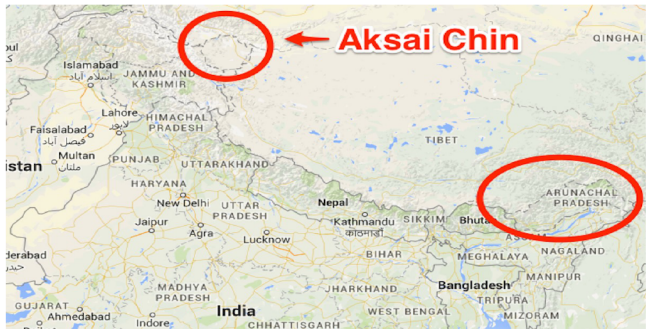
Businessinsider.in
Another unchecked area of the Chinese influence is the audit of their companies’ Corporate Social Responsibility (CSR) initiatives. The ambiguities in the use of CSR funds by the Chinese companies have led to deep concerns in the Indian civil society and strategic communities. It is believed that Xiaomi spends its CSR funds for creating a proChinese atmosphere in India, especially in the tech cities.
In fact, a director and vice president of the company, based in India, courtedn controversy for terming the “Boycott China” movement after the Galwan clash as “mob mentality”. The director, with a deep love for photo-ops, is popular among top Indian leaders across political lines, besides having close ties with policymakers and industry leaders. Incidentally, the Indian branch of the company is backed by some top-notch law firms, where a transactional equation based on money would matter more than sovereign national interests.
For his remarks, Xiaomi’s India director was slammed by the powerful trade association, Confederation of All India Traders (CAIT). A statement released by the body mentioned that the statement issued by him was “most insensitive and disrespectful”. The trade body saw him as someone who is “completely oblivious to ground reality, passing such remarks only for business gains, putting aside and completely dishonouring the sacrifice and martyrdom of brave Indian soldiers.”’” Despite obliquely challenging India’s territorial integrity and shamefully disrespecting the sacrifices of Indian soldiers, Xiaomi has managed to become a top Chinese mobile phone brand in India occupying more than onefourth share of the Indian smartphone market. The company is also believed to have links with powerful personalities and prominent celebrities in the country.
Another Chinese company Huawei, which has been hit by a global boycott/ban of its 5G projects worldwide, also enjoys a powerful reputation among Indian business leaders and policy communities. While this Chinese company was pushing for its 5G trials in the country, the Chairman of a top Indian telecom company came ahead to endorse it, terming it “significantly superior” to its European rivals and stating that the company should be allowed in the country’s 5G trials.
When both the Chinese companies Huawei and ZTE got permission for 5G trials, the then director general of Cellular Operators Association of India (COAI) Rajan Mathews said, “we are pleased that these trials are commencing, as we try to catch up with other markets. COAI has been working with tele-companies and the vendor community for the trials. They (Department of Telecommunications) want to start trials as soon as possible and will review applications for compliance. There is a keen interest to conduct trials from everyone. COAl is a powerful industry body and is believed to influence decision-making in the telecom and digital industries of India to a great extent. It is both shocking and horrifying to see the intensity and depth of penetration of the Chinese in such powerful Indian entities to such an extent, where the Indian body even lobbied in support of a company having connections to PLA.’
Several established facts highlight that Huawei is directly controlled by China’s PLA and has been tasked to interfere in the communication systems of different countries. According to its 2017 annual report, the Huawei group received a mix of conditional and unconditional Government grants totaling 1,504 million Yuan (approx. $230 million) for the year ending 31 December 2017.” Further questions arise because its head, Ren Zhengfei, was part of the militarg’s engineering corps, retiring as deputy director in 1983, when the corps was disbanded.
Nevertheless, journalists and research scholars like Ananth Krishnan, Visiting Fellow at Brookings India, who was based in China from 2009 to 2018, believe that it is “overstating the case to say Huawei is part of the People’s Liberation Army, or that Ren was a senior PLA figure. Most folks with engineering and technical backgrounds like Ren in the 1950s and 1960s had few options besides the PLA’s engineering corps.
Notwithstanding these expressions of support, doubts about Huawei’s nexus with the PLA remain. The Head of US FCC, Ajit Pai, also raised concerns about Huawei’s equipment such as routers, which “channel out hostile software powers to eject viruses and malware and steal Americans’ private data, spy on US companies and more…. Also, to hold free and open spectrum auctions with relatively reasonable reserve prices to enable spectrums’ deployment to the highest value to the user.
Allegations that are levelled are serious, as the telecom company operating in India was presumably found to be diverting all calls made from India via their server to their China headquarters. This means that their headquarters had the recordings of every call that was made on that network, which is a clear breach of privacy — an integral part of the right to life. But strangely, no debate on this vital issue seems to be gaining momentum in India.
Also, unlike other Chinese tech companies, it prefers to appoint Chinese nationals as its India directors, which is another factor that has been adding to the concerns of security strategists, as it might be one of the mechanisms to ensure direct control of the PLA in operations of Huawei and its influence tactics.
Besides compromising communication networks, Huawei is also believed to be indulging in covert influence operations in India. The company has been targeting impressive investments as part of their CSR activities across varied sectors. Huawei has successfully fought dozens of cases and maintains a huge team of lawyers and top advocates in India.
ZTE Telecom India Private Limited is another company working to set-up 5G in India.
It is a sad state of affairs that the company had been supplying its mobile equipment to state-run BSNL. According to a reply by Minister of State for Communications Sanjay Dhotre in Indian Parliament in September 2020, more than 44 per cent of mobile network equipment of state-run BSNL is sourced from Chinese firm ZTE and nine per cent is sourced from Huawei.
Similar to Huawei, ZTE also prefers to appoint Chinese nationals as its India directors and a number of prominent law firms/lobby groups, mostly having expertise in international businesses as advisors, represent the company in legal matters.
Not too different, Tencent Holdings India is another major Chinese tech company, which currently is rapidly investing in Indian startups. The Indian office-bearers of this company have a significant influence on the powerful industry body and lobby group IAMAI (Internet and Mobile Association of India) and have successfully been pushing the company’s interests through the Indian decision-makers.
The company is believed to have hired top lobbyists in India as its office-bearers. Some major Indian law firms have been successfully cracking deals for the company. As reported between April 2019 and January 2020, the company finalised 10 funding deals and now exercises substantial control over the Indian tech market through investments and share purchase.
| Company | Investor | Sector |
| Bigbasket | Alibaba Group | E-commerce |
| Dailyhunt | Alibaba Group | Search Engine |
| Healofy | Alibaba Group | Social Networking |
| Paytm Mall | Alibaba Group | E-commerce |
| Paytm.com | Alibaba Group | Payment System |
| Ticketnew | Alibaba Group | Movie Tickets Booking |
| Vidooly | Alibaba Group | Video Analytics & Marketing |
| Xpressbees | Alibaba Group | E-commerce |
| Rapido | Alibaba Group | Bike Taxi Aggregator |
| Snapdeal | Alibaba Group | E-commerce |
| Zomato | Alibaba Group | Restaurant Aggregator |
| Byju’s | Tencent | Education |
| Ola | Tencent | Transportation |
| Doubtnut | Tencent | Education |
| Dream 11 | Tencent | Gaming |
| Flipkart | Tencent | E-commerce |
| Niyo | Tencent | Fintech |
| Gaana | Tencent | Entertainment |
| Hike | Tencent | Social Media & Entertainment |
| Khatabook | Tencent | Fintech |
| MXPlayer | Tencent | Entertainment |
| Mygate | Tencent | Security Management |
| Pine labs | Tencent | Finance |
| Pocket FM | Tencent | Entertainment |
| Practo | Tencent | Medical |
| Swiggy | Tencent | Restaurant Aggregator |
| Udaan | Tencent | Commerce |
| City Mall | Xiaomi(Shunwei Capital) | E-commerce |
| Hungama Digital Media Entertinment PvtLtd | Xiaomi(Shunwei Capital) | Entertainment |
| Marsplay Internet | Xiaomi(Shunwei Capital) | E-commerce |
| Oye! Rickshaw | Xiaomi(Shunwei Capital) | Transportation |
| Rapido | Xiaomi(Shunwei Capital) | Bike Taxi Aggregator |
| Sharechat | Xiaomi(Shunwei Capital) | Social Networking |
| ZestMoney | Xiaomi(Shunwei Capital) | Fintech |
The companies that Tencent has massively invested in include Swiggy, Ola, Dream11, Doubtnut, BYJU’s, PolicyBazaar, Udaan, MX Player, MyGate, Khatabook and Niyo Solutions, which are the most dominant firms in the Indian app world today. It has close to $2 billion of exposure in India across 15 startups, which evidently have the highest ratings in terms of popularity and user base.
In the tech world, another Chinese company Alibaba.com India E-commerce Private Limited, is believed to be actively engaging in Chinese influence operations but in a subtle manner without catching the attention of Government agencies. Ant Financial, the fintech arm of the Jack Ma-owned tech conglomerate Alibaba Group has invested close to $2.7 billion in India across seven companies including Paytm, Paytm Mall, Snapdeal, etc.
To lure the Indian business community, Alibaba.com recently hosted an online summit, “Go Global 2020 — Make in India, Sell Globally”, for MSMEs in India. More than 2,200 export-focused businesses from across India are known to have participated in this summit. For influence and lobbying in socially relevant sectors, The Global Forum of Alibaba Group’s XIN Philanthropy Conference was held in India on 5TM September 2018 under the theme of “Love and Infinity” with an emphasis on Education, Child Protection and Women Empowerment. During the conference, with the participation of linked NGOs, civil
society groups, and think tanks, the ways in which the Internet could empower global philanthropic endeavours creatively and effectively were also discussed. Interestingly, the Philanthropy Week Conference was held simultaneously at Hangzhou and, for the first time, in New Delhi as an overseas location, signifying India’s importance to the Alibaba Group.

As discussed earlier, the Chinese conglomerate Tencent has invested in numerous companies including the multilingual self-publishing platform Pratilipi, owned by Nasadiya Technologies. The firm raised around Rs 71 crore in its investment round through the Chinese company. Besides this, Pratilipi also raised $15 million in a previous investment round from another Chinese firm Qiming Venture Partners. With such massive Chinese investments, apps like Pratilipi stand at the immediate threshold of conducting an influence-based operation on the orders of their Chinese bosses at any moment, owing to their wide user base and ability to select local writers to fire up their propaganda literature.
Another mobile app giant ByteDance, which faced backlash during the ban of 59 apps by the Government of India, has also been in controversy for indulging in Chinese influence operations. The company was in the process of investing $1 billion in India. It had established “interpersonal” relations with TikTok “influencers”, in its efforts to impact public opinion in the country. ByteDance also used to pay influencers to run campaigns promoting specific Products, issues, and ideologies.

Just like the other major Chinese firms operating in India, ByteDance also maintains a huge team of lawyers and policy experts. However, senior advocates Mukul Rohatgi and Abhishek Singhvi refused to appear for the company when most of their apps were banned in a crackdown on Chinese apps.
On a dangerous note, TikTok has even been accused of serious data breaches involving privacy intrusion. In a June 2020 study, Apple suddenly caught TikTok secretly spying on iPhone users. Following this, the company has been included in the national security review in the US.

is also among 59 Chinese apps banned in India | Source: Pixabay
World over, alarm bells have been ringing for Chinese apps. Investigative news reports of reputed newspapers like “The Guardian” have exposed that TikTok is actively involved in censoring content that does not appeal to the Chinese Government. Most of such Chinese apps are now under security review in not just the US and India, but also in many European countries.
In India, it is also important to note that the former Telecom Regulatory Authority of India Chairman, Pradip Baijal, had told ET Telecom that “the UPA Government allowed Huawei and ZTE despite the Research and Analysis Wing’’s (RAW) objections. Both companies should not be allowed given the strategic nature of telecommunication equipment”. Those objection points need to be revisited by the concerned authorities to take them further,’! as the world has already started to understand the nefarious design of these companies.
What cannot be negated, however, is that two large industry groups have been dominantly lobbying for Chinese tech firms in India — Internet and Mobile Association of India (IAMAI) and Cellular Operators Association of India (COAIl). IAMAI has been lobbying for TikTok and Tencent, whereas COAI has been lobbying for Huawei and ZTE. These are powerful lobbies that the Chinese firms have very intelligently catered to.
Within the country, the Standard Operating Procedure of selecting the Indian leadership for these Chinese tech companies could be classified under two categories.
Firstly, companies like ByteDance, Xiaomi, and Tencent, find one person as their India head/director, who is usually a lawyer or an industry lobbyist and build his/her own team by recruiting their old confidantes. | In the second category, companies like Huawei and ZTE, appoint Chinese citizens as heads of their India businesses, who then collaborate with Indian industry leaders and policymakers to lobby and grow their businesses.
These companies have been resorting to multiple ways of lobbying that run parallel to each other. Firstly, most of them have been involved in a significant amount of CSR initiatives and philanthropy events. Secondly, prominent officials of these companies try to establish a personal connection with the bureaucrats and political leaders to increase their influence in decision-making. Thirdly, they also try to influence decision-making by joining the industry associations directly – as in the case of Tencent or by appointing their loyalists – as in the case of Huawei.
This form of China’s slow and institutionalised meddling in other countries is not new.
The American Federal Bureau of Investigation (FBI) has kept Chinese nationals Jiang, Qian, and Fu under watch since 2015. The CCP Government fosters these cyber army operatives through a give-and-take relationship. While the Government allows them to operate and take the benefit of their location to deploy ransomware and illegally mine cryptocurrency, the CCP deploys the same operatives for phishing data about educational institutions, Government officials, financial institutions, and basic infrastructure. So powerful are these teams that some of the CCP sponsored cyber soldiers crippled one of the key Taiwanese energy companies and disrupted their supply.
Though dozens of Chinese apps, with potential threat of data breach, have been banned by the Indian Government, several other Chinese apps which have ambiguous privacy policies and have unauthorised access to the personal data of users are still operating within the country. Interestingly, a large chunk of these apps is actually dating apps, where the young and vulnerable share a lot of personal information.
The basic idea behind these Chinese apps is to lure the users and make them addicted to these, while simultaneously breach/steal maximum amount of data by routing their servers or through indirect servers. By installing cookies in user’s phone, these apps begin to track the details and activities of the users. The biggest concern is that data of these applications are hosted in servers based out of China, exposing the data of Indian citizens to China, which it conveniently uses for influence operations and analysis about the country. As they say, knowledge is power, and by using this data China intends to advance its own interests, sociologically and economically, particularly in times of competition and conflict.
These apps bring along with them several vulnerabilities capable of compromising the privacy and security of the users. Tech policy experts have argued that besides leaking sensitive personal data, they have the potential to install other unwanted apps or can kill other apps installed in the smart phone. Besides, these apps might delete packages installed on the smart phone, receive a list of all the apps with specific intent receivers, or wrap-up and hide other apps, along with many actions leading to privacy breach.
FOOTPRINTS OF CHINESE INTELLIGENCE
India’s trade and investment strategy with China has been slow to grasp the rising trend of Chinese influence operations through startups and businesses. India has primarily had two areas of focus — opening up China’s market, particularly for Information Technology and Pharma sectors and bringing in Chinese investments to India, particularly in the Manufacturing sector. A lot of energy has been, and is being, expended in both these areas. However, both have largely failed to bear fruits, primarily because these focus areas do not suit the objectives or the interests of China and the CCP. In the IT and Pharma sectors, what China is seeking is to develop and acquire the capabilities on its own through acquisitions and mergers. Fosun’s $2 billion acquisition of the Indian company Gland Pharma is a case in point. In realm of IT, if we consider that the only Indian IT company to be successful in China is NIIT, which is not selling Indian IT services or products, but training tens of thousands of young Chinese in IT skills every year, so they can bolster Chinese IT companies rather than rely on Indian ones, we realise that the odds are largely against us.
In contrast, there has been little attention at the official level in India when it comes to investments in technology. That is because understandably, India’s focus was on Greenfield investments. However, it is only in the past two years that the Indian Government has started trying to cash on this trend of startups and has brought Indian start-ups to China on essentially fund-raising missions. Because it has been behind the curve, there has been extraordinarily little regulation in this space.
In the recent case of detainment of three Chinese agents operating in India, payments were made to Rajeev Sharma through Hawala route. The origin of this espionage was further traced to Jhang and Chang-Li-La, who were working along with the Chinese Ministry of State Security. The companies were registered as MZ Pharmacy and MZ Malls under the identities of an Indian and a Nepalese citizen. The company aimed to pass the information received from Sharma to the two Chinese nationals based in China, who would then pay him in retrun. This information flow was reaching intelligence officials in Yunnan province of China.
A recent expose made by the “Indian Express” also revealed that a Shenzhen-based innovation organization Zhenhua, with connections to the Chinese Government, and the CCP, is snooping on Indian people and associations in its worldwide information base of “unfamiliar focuses”. The organization has been alleged of snooping on top Indian pioneers, VVIPs, with the rundown including 10,000 conspicuous individuals and associations. The data, being collated and organised, was being observed progressively by Zhenhua Data Information Technology Company.
The targets of Chinese snooping included prominent personalities from President of the country Ram Nath Kovind and Prime Minister Narendra Modi to Indian National Congress president Sonia Gandhi and their respective families; Chief Ministers Mamata Banerjee, Ashok Gehlot, and Amarinder Singh to Uddhav Thackeray, Naveen Patnaik, and Shivraj Singh Chouhan; Cabinet Ministers Rajnath Singh and Ravi Shankar Prasad to Nirmala Sitharaman, Smriti Irani, and Piyush Goyal; Chief of Defence Staff General Bipin Rawat to 15 previous Chiefs of the Army, Navy and Air Force; then Chief Justice of India Justice Sharad A. Bobde and Justice A. M. Khanwilkar to Lokpal Justice P. C. Ghose and Comptroller and Auditor General G. C. Murmu; top tech business stalwarts like Nipun Mehra of Bharat Pe (an Indian installment application) and Ajay Trehan of AuthBridge, a verification innovation firm to top industrialists such as Ratan Tata and Gautam Adani.
The Indian Government has recently identified a couple of major Chinese companies operating in India with connections to the PLA. Xindia Steels Limited is one of the largest joint ventures between India and China. The main investor of Xindia Steels is Xinxing Cathay International Group Company Limited (China) and has links to the General Logistics Department of the PLA. Another company with PLA connection is the Xinxing Cathay International Group, which has made an investment of roughly Rs 1,000 crore in an effort to set up a manufacturing facility in Chhattisgarh. Similarly, China Electronics Technology Group Corporation (CETC) – China’s leading military electronics manufacturer, which produces Hikvision CCTV cameras – invested $46 million in a manufacturing facility in Andhra Pradesh’s Sri City in 2018. The CETC has already been pulled up by the US Justice Department for illegal exports and its employees have also been convicted of military espionage.
China has also recently started an initiative to use the soft spots of the nation to plant its espionage racket. Keeping a keen eye over the execution of infrastructure, telecommunications and engineering projects, a trend has been observed lately where the Chinese companies have emerged to be the lowest bidders in the Government projects in states such as Haryana, Maharashtra, and Chhattisgarh. This makes them eligible for a grant of tender for all these crucial projects. Insiders also believe that China aims at opening branches of its educational institutes in West Bengal and Tamil Nadu in efforts to cash on the educational and cultural ties, for the benefit of its espionage network in these sensitive border states.
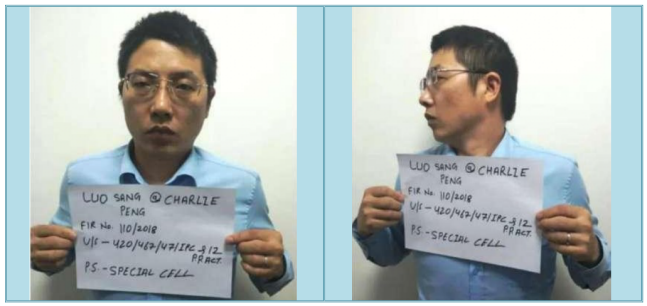
CTA | Source: Haryana Police
China is keen and always keeps an eye on India, more so because of its Tibetan connections. The Central Tibetan Administration (CTA), run from Dharamshala and previously headed by the His Holiness Dalai Lama, is a cause of continuous discomfort for China, which has repeatedly tried to curb the Tibetan freedom struggle with harsh measures. The arrest of Luo Sang by the Enforcement Directorate in September 2020 resulted in shocking revelations about the involvement of the Chinese Ministry of State Security in sabotaging the Dalai Lama and the Tibetan freedom struggle. Sang was arrested on charges of running a Hawala racket of Rs 1,000 crore. This amount was used to pay for snooping on the Dalai Lama and the CTA. This infiltration specially targeted the Tibetan settlements in India at Delhi, Karnataka, and Himachal Pradesh.
Besides visiting Himachal Pradesh and other areas with Tibetan settlements, Chinese nationals have also been seen in areas where there are Buddhist monasteries and prominent Buddhist-inhabited areas of West Bengal and Arunachal Pradesh. They have been observed interacting with Buddhist monks, clicking pictures, and doing a recce of these monasteries.

October 16, 2018. | Source: APN News
Over the years, Chinese spies coming to India have used Nepal as the preferred route of entry. Nepal has also become a destination for Chinese espionage. News reports highlight that the planting of Chinese intelligence operatives in Nepal had started in the times of Mao Zedong when he made the infamous statement about the expansionist agenda of China that, “Tibet is the palm of China but Nepal, Bhutan, Sikkim, NEFA, and Ladakh are its fingers”. Since those times China is known to foster pro-Communist and antidemocracy regimes all over the world. Mao extended full support to the deadly Naxals in India in their routine bloodshed of civilian and police lives. With the establishment of the CCP Government in China, spies were planted all over Nepal to prepare for an all-out war with India, which may never occur in a conventional sense with armed forces. However, with the establishment and maintenance of a pro-China Government at Kathmandu, there are reasons for India to be concerned. Considering the open Indo-Nepal border, China could foment trouble for the former through the latter.
China has deployed a massive drone armory across the Indo-Nepal border for reconnaissance. Though Nepal argues that it has deployed the drones, strategists suggest otherwise. This is a cause of major discomfort for India, as it will pave way for China to infiltrate terrorists, supply arms and ammunition to separatist insurgents in India towards the achievement of its goal of “Unrestricted Warfare”. Besides, several news reports have emerged in the Chinese state media that it has deployed a helicopter drone on the Sino-India border during the current LAC standoff for the recce of Indian border areas.
China has also been attempting to exploit the vulnerabilities related to the Gorkha soldiers working in the Indian Army and has deployed its influence operatives to gather information on this historical tradition, to sabotage it. To this end, China is known to have paid 1.27 million Nepali Rupees to an NGO for funding a study about the cause of motivation for Nepalese youth to join Indian Army. The payment has been made by the Chinese Ambassador Hou Yangqi to the think-tank China Study Center. However, IndiaNepal ties go a long way, as a total of 28,000 Nepalese citizens serve in the prestigious Gorkha Regiment of the Indian Army.
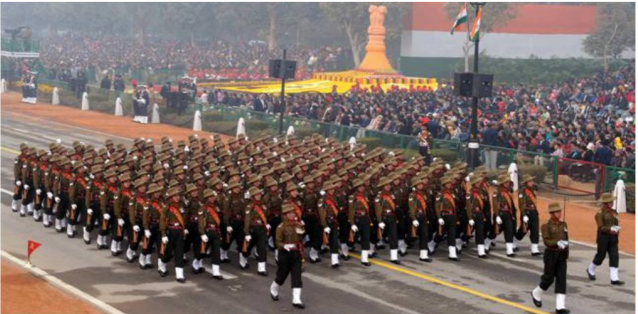
Republic Day Parade in 2016
Curiously, a report published in Taiwan Times in August 2020 mentioned China using pigeons as a mode of espionage in the eastern sector near the border of Arunachal Pradesh and Tibet. These pigeons are reportedly specifically trained to swoop and swerve over the Indian territory with cameras attached to their legs. This pattern was observed by the Indian soldiers at the post and further reported to higher authorities. It is believed that in the due course of two years, China has effectively mapped Kaho, Kabithu, Niti, Badrinath, Mana Pass villages near the border using this technique. The pigeons being excellent navigators are trained to return to their bases and the cameras attached to their legs transmit the low altitude imagery to the intelligence officials, who further work upon the plan to infiltrate into Indian territory. The report mentions that the Chinese intelligence agencies are under immense pressure to safeguard the details of their spies and case officers owing to recent arrests in India, the US and Australia.
In another development, India’s advancement towards the closure of a peace deal with the Naga rebels in its North-East is causing major discomfort to the Chinese, who are vehemently trying to sabotage the peace process. China sent a spy disguised as a media reporter to the region – Wang Qing, who was arrested on 25″ January 2011 after she held a closed-door four-hour talk with the Naga leader of the NSCN-IM faction, Thuingaleng Muivah. It is well known that China has been trying to interfere in the internal administration of the North-eastern states, but this event proved to be extremely audacious on the part of the Chinese. The Government of India also gathered evidence about Anthony Shimray from NSCN-IM indulging in espionage, who was later apprehended by the Indian authorities. He confirmed that the Chinese agents approached him with a deal regarding surface-to-air missiles in lieu of $1 million. He further admitted that the NSCN-IM rebels supplied the details of Indian Army’s posts and operations in return for a Chinese passport. Shimray is known to be the chief procurer of weapons for the NSCN-IM via the Chinese companies engaged in the manufacture and distribution of defence supplies. Shimray also admitted to meeting the head of the intelligence services in Yunnan province to convey a message requiring help from Chinese intelligence agencies.
News reports state that way back in 2013, the Indian Government noticed that the Chinese espionage models have now chosen a much safer disguise to operate and work in India by infiltrating the monasteries. The Central Tibet Administration further confirmed these fears. Accordingly, a thorough security audit was ordered by the Government of all monasteries. These vulnerabilities were brought to notice by the Sashastra Seema Bal (a border guarding force of India focusing on the frontiers with China) as well, which observed the emergence and set up of many new monasteries in the border areas lately and suspected it as an attempt not only to track Dalai Lama but also to bypass the national security apparatus of the country, providing a safe entry for the Chinese spies disguised as monks. Moreover, the traditional proximity of Nepal’s Maoists to China has led to the development of strange equations between the Nepali police and the Chinese intelligence agencies. The 2010 information-sharing agreement between Nepal and China has left the Tibetan population there vulnerable to maltreatment by the Nepali police. The influence of China on Nepal is massively growing and is a major cause of concern to India. Strategically, Chinese intelligence services have opened and routinely funded the Mandarin language schools all along the border in the past decade.
Against this backdrop of Chinese espionage, recently, the data of 1.95 million CCP cadres was leaked by a whistleblower to Inter-Parliamentary Alliance on China (I-PAC), which further shared it to an international consortium of four media organisations: The Australian, The Mail on Sunday in Britain, De Standaard in Belgium, and Swedish journalists. According to The Australian, “the database shows CCP members have been or are currently employed in Australian, US, British, German, Swiss, Indian, New Zealand, Italian and South African missions in Shanghai.
Reports have claimed that the CCP workers have also infiltrated two top defence companies, whose subsidiaries are operating in the Indian Defence Manufacturing sector — such as American firm Boeing and European company Airbus. Any Chinese influence from the top could mean compromising secrets as well as information on the status of Indian defence production. Reports also suggested that CCP members have also infiltrated into French military electronics major Thales, which is a big player in the Indian Defence Manufacturing sector. The threat of Chinese impact becomes much graver as Thales has acquired Gemalto – a dominant player in the Indian digital ID and data business. Even a feeble influence of CCP cadres working in Thales can expose biometric data of over a billion Indians. The leaked data has revealed that CCP cadres had also infiltrated companies like Pfizer and AstraZeneca — top Pharmaceutical companies known to be producing Coronavirus vaccines.
According to investigations following the leak, it was revealed that the CCP used the Government agency called the Shanghai Foreign Agency Service Department (SFASD) to assist consuls and missions across Shanghai to hire local staff – only to ensure that CCP cadres are placed in consulates. The SFASD has close connections with the “Indian Association in Shanghai” and also has been hosted by the Indian Consulate in Shanghai. It has also partnered with the Indian Consulate in social activities like blood donation drives. Since a decade, the SFASD has been organising annual blood donation drives in association with the Indian Consulate in Shanghai.
Quoting an expert, the story published by “The Australian” on basis of the leak, says, “There’s a lot of overlap in the Chinese system between spying and foreign interference operations. The Ministry of State Security often uses the Shanghai Academy of Social Sciences (SASS) to recruit foreign academics.
ILLICIT CHINESE TRADE PRACTICES AND TRADE DEFICIT
As per records, China represented over five per cent of India’’s complete fares in the fiscal year 2019-20 and over 14 per cent of its imports. India is the biggest export market for China. While the total estimation of imports from our neighbour may have fallen, their offer in the general pie rose by about 13.7 per cent as compared to 2018-19.
Chinese exports to India include cell phones, electrical machines, power plant inputs, fertilisers, auto segments, finished steel goods, capital merchandise like energy power plants, telecom gear, metro rail coaches, iron and steel items, drug items, synthetic substances and plastics and designing products, in addition to other things, as per the Ministry of Commerce.
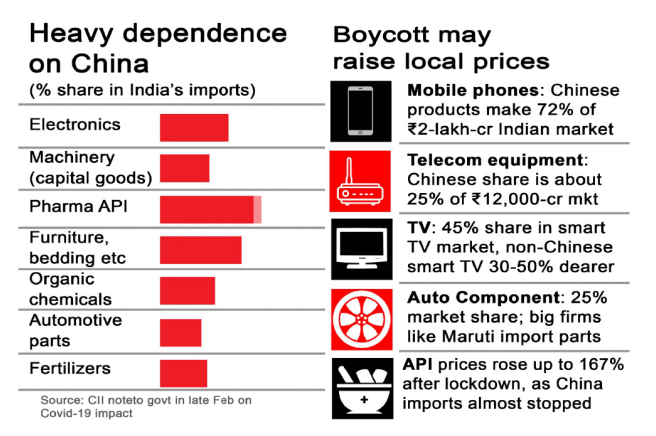
Foreign direct ventures from China come to metallurgical businesses, environmentally friendly power (solar boards), electrical gear, car, and synthetic substances. The China Global Investment Tracker demonstrates Chinese FDI into India to the tune of $4.14 billion for 2019. China’s business service, pegs the figure at $8 billion for 2018-19.
Over 80 per cent of India’s solar component supplies have been hijacked by the Chinese firms. Aggressive pricing on the back of state subsidy, a protectionist outlook and cheap finance have allowed Chinese manufacturers to out-price their domestic counterparts. Products of Vikram Solar are 8 per cent to 10 per cent costlier than Chinese imports. India’s aggressive solar energy targets would mean business worth over $40 billion for component manufacturers over the next five years and China plans to make the most of it. Knowing this trend, countries like the US and even those in Europe, are increasingly taking measures to protect themselves against Chinese dumping. Taking a leaf from them, India too, is trying to strike a reasonable balance between free trade and protecting the interests of its citizens.
About a decade back, traders often used to source products such as toys, plastic buckets, idols of Indian gods, etc. from domestic manufacturers. In toys business alone, many Indian manufacturers are known to have employed 500-plus people as their suppliers. Today, however, cheap, and caustic Chinese toys have flooded the market.
Indo-China trade has surpassed $70 billion, but remains heavily skewed in favor of China. From $37.2 billion in 2011-12, the trade deficit has widened in the last six years to $51.1 billion, with Indian imports from China amounting to $61.3 billion and exports to the country totalling at $10.2 billion.
Over the years, China has taken a range of policy measures to create, protect and nurture its own companies. In most sectors, it has built Multi-National Company (MNC) giants like Alibaba (China’s answer to Amazon), Baidu (China’s Google), WeChat (China’s Facebook), and Xiaomi (China’s Apple). Steadily, these Chinese firms have evolved from opting technology produced in other countries to making their own versions of it and building world class MNCs that would dominate and call the shots of the day.
The Automobile sector is another example of Chinese dominance. Chinese carmaker Geely, which once made models like King Kong and Rolls-Royce copycat Geely GE, has come a long way. Snapping up Volvo’s passenger car business in 2010, Geely today is competing with Audi, BMW and Mercedes and eyeing the luxury car market with an allelectric thrust.

copy of Land Rover, Land Wind by Jiangling Motor Holding
In the Telecom sector, Chinese companies,at present, have the largest market share. In handsets, they control 51 per cent of India’s $8 billion plus smartphone market with brands like Xiaomi, Oppo, Vivo and OnePlus. The same story has been playing out in the Telecom Equipment sector too.
Despite a vibrant telecom sector, India imports telecom gear worth over Rs 70,000 crore annually, much of it from Chinese firms like Huawei and ZTE. “China has always protected its own firms and pushed companies like Apple to set up data servers locally to cater to Chinese security concerns. In the current geo-political tension, India’s concerns are natural,” says Jayanth Kolla, founder of telecom consultancy firm Convergence Catalyst.
In India, such policies have never been implemented. Indian agencies face the brunt when they cannot retrieve any data from the tech giants as part of their security measures.

Chinese electrical goods, electronics, and smartphones | Source: Sup Delhi
It is the same story in the power sector. In the 12th Plan alone, almost 30 per cent of the generating capacity was imported from China. In the rapidly growing solar energy sector too, between April 2016 and January 2017, solar equipment from China had a share of 87 per cent in a market pegged at $1.9 billion.
According to consultancy firm Grant Thornton, in 2017, when inbound deals dipped, the Chinese shifted gears and accounted for 31 per cent of the inbound deal value as against 27 per cent from the US. China’s Tencent Holdings has so far invested $700 million in Flipkart. Chinese digital giants have also been investing heavily in India’s digital ecosystem – Alibaba in Paytm, and CTrip in Make My Trip. Chinese real estate firms like China Fortune Land Development Company and Dalian Wanda are entering India with multibillion dollar plans for industrial townships and similar projects. And Haitong Securities was one of the investment banks that managed the public issue of shares of the Central Depository Services.
Thus, it is amply clear that the Chinese have been muscling their way into the Indian business arena for quite some time. From being India’s largest trading partner, China is now fast-growing into a source of Foreign Direct Investment (FDI). Through their investments, Chinese are increasingly dominating industries like mobile phones and are in the process to grab the lion’s share in the television and home-appliances industries too.
Truly, India is a “hot investment opportunity”, as Li Bojun, a counsellor at the Chinese embassy, was quoted saying in the “People’s Daily” in February 2017. Chinese companies are seen showing more confidence in the Indian economy as it grows faster than their own and narrows the gap in competitiveness between the two Asian giants. India is ranked 39th, compared with China at 28th, in the World Economic Forum’s Global Competitiveness Report on 138 nations in 2016-17, marking an increase in its rank by 16 positions from the 55th in 2015-16.
Interestingly, the Parliamentary Standing Committee on Commerce (Chair: Naresh Guijral) submitted its report on “Impact of Chinese Goods on Indian Industry” on 26th Ju|y 2018, in which it was stated that bilateral trade between India and China increased from $38 billion in 2007-08 to $89.6 billion in 2017-18. While imports from China increased by $50 billion, exports inched up by $2.5 billion during the same period. This has widened India’s trade deficit. Trade with China constitutes more than 40 per cent of India’s total trade deficit. Key observations and recommendations of the Committee include:
- Anti-dumping duty: Dumping refers to the practice of exporting goods at a price lower than their market value in the originating country. The importing country conducts detailed investigations and imposes anti-dumping duty for these goods. The Committee noted that: (i) India’s anti-dumping duties on Chinese goods are being evaded by misclassification of products, and (i) the Government is reluctant to review the effectiveness of anti-dumping measures undertaken by it. The Committee recommended that the Directorate General of Anti-Dumping: (i) address the problem of lax implementation of anti-dumping duties, and (ii) rationalise the duties and make them more in line with current domestic production costs.
- lllegal imports and smuggling: The value of seized smuggled goods from China was Rs 1,024 crore in 2016-17. The Committee noted that the Directorate of Revenue Intelligence (DRI), India’s chief anti-smuggling intelligence and investigations agency, works in a challenging environment with a small workforce. It recommended that the workforce of the DRI be adequately augmented to check smuggling.
- Impact on Micro, Small and Medium Enterprises (MSMEs): The Committee noted that poor quality Chinese products dominate the unorganised retail sector. This sector comprises domestic MSMEs, producing more expensive but better-quality products. The Committee noted that there is a need to promote domestic MSMEs. It suggested that the import of finished goods be taxed at the highest rate, and raw materials at the lowest, to boost domestic production.
- Pharmaceutical Industry: There is heavy reliance on Chinese imports for raw materials in the Pharmaceutical industry. In some cases, such as for life-saving drugs, the dependence on Chinese imports is almost 90 per cent. The Pharmaceutical sector requires extremely high initial investment. The Committee suggested that a long-term view of the Pharmaceutical industry be taken to promote competition and price stability. It also recommended that the Government provide adequate infrastructure support to this industry.
- Solar Industry: Around 84 per cent of the solar requirement of the National Solar Mission is met through imports from China. The Committee noted that import prices of such commodities in India are lower than their import prices in Japan and Europe, suggesting that Chinese goods are being dumped in Indian markets. It recommended that:(i) trade remedial measures, like anti-dumping duties, be taken to protect the domestic solar industry, and (ii) quality standards be imposed to ensure that imported Chinese solar products do not contain harmful substances such as antimony.
- Textile Industry: The Committee noted that the existing Goods and Services Tax (GST) on synthetic fibers of 18 per cent has increased the import of similar fabrics from China. Further, India has Free Trade Agreements (FTAs) with Least Developed Countries such as Bangladesh. Chinese fabric is manufactured into garments in Bangladesh and imported at cheap rates into India. The Committee recommended that such FTAs be reconsidered, as they nullify the effect of the anti-dumping duties on imports from China. Further, it also recommended that the Government take steps to modernise this industry.
- Firecracker Industry: The Committee observed that most Chinese firecrackers contain potassium chlorate, a highly explosive chemical banned in India. It recommended that the import of hazardous Chinese firecrackers be banned, as they involve public health concerns. The Committee also noted that the domestic firecracker industry is valued at Rs 4,000 crore and is one of the most labor-intensive industries. It recommended that the existing GST rate of 18 per cent be lowered to promote this industry.
- Bicycle Industry: The Committee observed that the demand for bicycles in India has increased lately, mainly due to public bike share programmes under the Smart Cities Mission. The Committee noted that Smart City administrations, especially in cities like Pune and Coimbatore, have been showing a preference for cheap Chinese bicycles over Indian ones. The Committee recommended that the Government ensure Smart City administrations procure Indian bicycles under the Public Procurement (Preference to “Make in India”) Order, 2017.
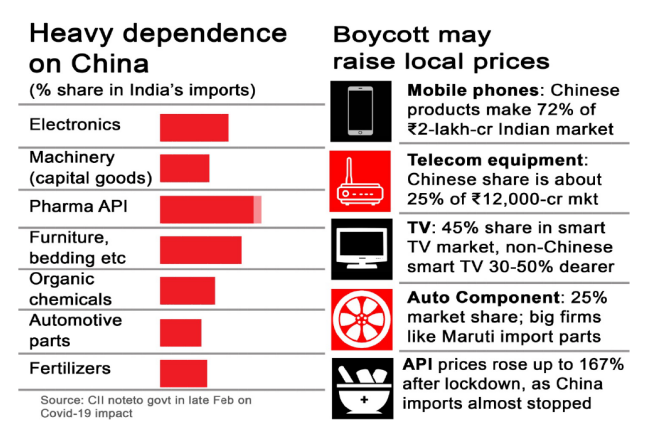
Efforts to reduce economic engagement with China have started to fetch results, as India’s trade deficit with China has eventually started to narrow down. It has come down to $48.7 billion during the fiscal year 2020, as compared with $53.6 billion a year ago.
To further its interests, China is relentless in its pervasive presence across various Indian sectors. Prof Zack Shengzhi, who has connections with around a dozen prominent universities in Delhi-NCR and South India and founder of the Sino-India Education and Technology Alliance, was offered the post of Chair of the China-India Business Council by the Chinese Government after the Doklam standoff in 2017. The Professor also helped to establish the Liaison Office of the China-India Business Council to facilitate economic interest of China in India. Since then, he has been extensively lobbying with the Indian
industry leaders and policymakers and made several visits to meet top Government officials of few states among other measures.
Another individual lobbying for Chinese interests in India is Liu Xiaodong — Deputy Chief Representative of China Council for Promotion of International Trade (CPIT). A couple of stakeholders from the industry have revealed that CPIT has engaged in activities that do not fall under the business domain.
CHINESE INFLUENCE IN THE INDIAN POLITICAL SETUP
In 2009, when Indian political circles and civil society were outraged by a report from a Chinese think-tank urging friendly countries to divide and bifurcate India into 20-30 small nations, Communist Party of India-Marxist (CPI-M) refused to comment and criticise China.
On being questioned multiple times on its silence, CPI-M leaders maintained that the party cannot react without ascertaining the “authenticity” of the report. However, the party and its leaders have been aggressively questioning Indian Government’s foreign policy decisions and have been taking cognisance of American newspaper editorials to drive home its allegation that New Delhi was succumbing to Washington’s pressure.
Besides cash, China has been trying to influence Indian politics through kind as well.
In 2017, a regional channel broadcasted the visuals from CPI-M’s headquarters AK Gopalan Bhavan in New Delhi in which staff of the Chinese embassy were seen carrying gifts to the party headquarters.
In an editorial published in the 28″ June 2020 ediion of the CP I-M mouthpiece “People’s Democracy”, the party listed reasons for China’s aggression in Ladakh, particularly the Galwan Valley, blaming a few acts of the Indian Government for what had happened there. Rejecting the tactic of “Salami Slicing” by China, the editorial put the blame on Indian Government and argued that “the steps to dismantle the state of
Jammu & Kashmir and break it up into two centrally-administered territories of Jammu & Kashmir and Ladakh have had external repercussions. China saw it from its own standpoint. The Chinese Government protested twice to India that for them, this amounted to changing of an administrative arrangement, which has an impact on an area to which China has claims. But the Indian Government overlooked this response even when China got the matter raised in an informal session of the United Nations Security Council”.
Similarly, in another article published during the faceoff, Ganashakti — the Bengali language mouthpiece of CPI-Mtried to blame India and favoured the Chinese standpoint. It carried the statement of the Spokesperson of China’s Foreign Ministry arguing, “Indian Army on 15TMJune violated that agreement in a serious way. The Indian Army breached China’s border line twice for their illegal work. They also provoked Chinese soldiers and attacked them. This violation of protocol led to the physical clash.

CPI-M brass | Source: Chinese Embassy in India
The UN Charter and the Diplomatic Relations (Vienna Convention) Act – 1972, of which India too is a signatory, prevents the interference of diplomats in internal affairs and political matters of India. However, members of the Chinese Embassy in New Delhi have been meeting Indian leaders, overtly and covertly, to influence India’s foreign policy decisions. Breaching these international conventions, Chinese Ambassador Luo Zhaohui met a delegation of top CPI-M brass along with Counselor Zhou Yuyun of the Chinese embassy. On 17 March 2017, Chinese diplomats met the top leadership of the party including Sitaram Yechury, M.A. Baby, Nilotpal Basu, and others. Both the sides brainstormed to enhance party-to-party exchanges and cooperation between the CCP and the CPI-M. The Chinese Ambassador has been intermittently meeting prominent parliamentarians and journalists of India to ensure flawless propagation of the pro-Chinese narrative in India.
Back in 2007, on 28″ November, the then ruling United Progressive Alliance (UPA) Chairperson Mrs. Sonia Gandhi met with Mr. Wang Jiarui, Minister of the International Department of the Central Committee of the CCP. She recalled with pleasure her successful visit to China not long ago and said she was very much impressed by the fact that the Chinese leaders were keen on developing friendly relations with India. The Indian National Congress leader said her party would continue to push forward the development of bilateral relations between the two countries through friendly interactions with the Communist Party of China. She suggested that exchanges between the youth from both sides be increased so as to enhance the better understanding between the two populace. Mrs. Gandhi concluded that the friendship between China and India would be a positive factor in the peace and prosperity in Asia in particular and the world in general. Mr. Wang Jiarui said that Mrs. Gandhi’s visit to China opened a new chapter in the relations between the two parties. He had hoped that the Chinese side would endeavor to materialise the consensus reached by the leaders of both the countries by increasing the exchanges between the two parties so as to put new impetus into the strategic cooperative partnership between China and India.
During the all-party meeting on tensions along the LAC, leader of CPI-M Sitaram Yechury refused to criticise China and came with a number of “ifs and buts” in its press communique on the all-party meeting. Party’s press statement read, “In the talks between our Minister for External Affairs and the Foreign Minister of China, our official statement states: At the conclusion of the discussion, it was agreed that the overall situation would be handled in a responsible manner, and both sides would implement the disengagement understanding of June 6 sincerely. Neither side would take any action to escalate matters
and instead, ensure peace and tranquility as per bilateral agreements and protocols. As the Government of India has adopted this stand, the CPI-M extends its support to this approach.”
Declining to condemn aggression of PLA soldiers in Galwan valley, leading to martyrdom of 20 Indian soldiers, the CPI-M refrained from issuing any statement and just called it an “unfortunate” incident. However, the party was quick to condemn the US Government for the death of George Floyd, just a couple of days before the Galwan clash.
Similar to CPI-M, Communist Party of India (CPI), also refrained from condemning the PLA and the Chinese Government. In a short statement, the party expressed, “we feel that both sides have to intensify their efforts keeping in mind their core interest to achieve mutually acceptable solution to the India-China boundary question as soon as possible. Any military confrontation between the two major Asian countries not only impacts the cooperation and friendship between the two countries but also jeopardises the peace and stability in the Asia-Pacific region.
Also, going against the popular sentiments of the nation, CPI-M leader Prakash Karat has been taking on the “Boycott China” campaign after the Chinese aggression. In an editorial published in the party mouthpiece “People’s Democracy” on 3 May 2020, Karat strongly criticised the Indian media and academia for holding China responsible for the spread of COVID-19 pandemic. He wrote, “…the anti-China campaign has proliferated in India too. Editorials and commentaries have appeared critical of China and regurgitating some of the stuff in the western media. Though the Modi Government has not joined its friends like President Bolsonaro of Brazil in maligning China, the rightwing Hindutva forces are active in propagating absurd anti-China stories in the social media. For this deranged crowd, the Coronavirus threat is presented by Muslims internally and by the Chinese externally.” Expressing his concerns for companies moving from China to India, Karat further opined, “The United States is prodding India to curtail economic ties with China just as Japan is seeking to withdraw investments from China. Taking a cue from this, ministers in the Government are talking about wooing companies that have invested in China to come to India instead.
Another self-proclaimed “youth leader”, with strong connections to the Chinese Embassy in New Delhi, was one of the proponents advocating to the world to learn from China’s COVID-19 experience, praising its “resilience” and “promptness” to contain the pandemic. Similar articles authored by him seem certainly dictated by the Chinese Embassy in New Delhi.
Recently, reports on the Rajiv Gandhi Foundation are also doing the rounds. Apparently, it received funds from China periodically and influenced the policies of the then Manmohan Singh Government. Minhaz Merchant, a prominent journalist, had claimed that one of the main founders of the Rajiv Gandhi Foundation was Suman Dubey a former journalist, who was Rajiv Gandhi’s classmate at Doon School and a relative of Arun Shourie and Ajai Shukla (a former Indian Army officer and blogger). Interestingly, Ajai Shukla had once said, “the Border has not been decided yet. This border is being decided for the past 50-60 years and it will be settled at some point in the future. But right now, it cannot be said. Only an Indian can say that China has transgressed into our territory but from the perspective of China, they have not entered our territory.
Rajiv Gandhi Foundation was set up on 21% June 1991 to commemorate Mr. Rajiv Gandhi, the late Indian Prime Minister, who was assassinated by the Liberation Tigers of Tamil Eelam (LTTE). Its Chairperson Mrs. Sonia Gandhi is also the Interim President of the Indian National Congress party at present and Chairperson of the UPA. Mr. Sun Yuxi, the then Chinese Ambassador to India, on behalf of the China Charity Foundation, donated Rs 1,000,000 to Rajiv Gandhi Foundation during 2006-07 to give financial assistance to its charities. Mr. Manmohan Malhoutra, secretary-general of Rajiv Gandhi Foundation, expressed thanks and promised to inform the Chinese Embassy of the utilisation of the sum of money for charity. According to the returns filed by Rajiv Gandhi Foundation dug up by Twitter user @By2Kaafi, in the year 2006-07, the Government of China donated Rs 90,00,000 to the Rajiv Gandhi Foundation.
The Rajiv Gandhi Foundation’s Annual Report of the year 2008-09 says, “the year witnessed a high point when a high-level delegation from the RGF paid an official visit to China to participate in the celebrations to commemorate the 20″‘anniversary of Mr Rajiv Gandhi’s historic visit to China in 1989. The delegation, led by Mr. VeerappaMoily, Chairman of the Second Administrative Reforms Commission, included Mr. Salman Khurshid, former Minister of State for External Affairs, noted journalists Mr. Vinod Sharma and Mrs. Neerja Chaudhary, and Prof. Pratap Bhanu Mehta, President of the Centre for
Policy Research.
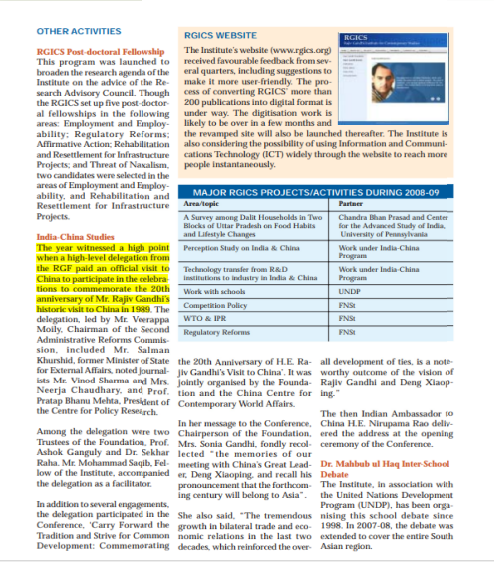
In April 2009, RGICS (Rajiv Gandhi Institute for Contemporary Studies — a division of the Rajiv Gandhi Foundation) Fellow Mohammad Sagib carried out a feasibility study, “India-China: Free Trade Agreement (FTA)”, in association with Dr. Purnachandra Rao. The main objective of the study was to gain a better understanding of an FTA between India and
China, analyse various trade issues and identify who would stand to gain and lose from such an agreement. The report concluded that China would be the greater beneficiary in all trade dimensions because of the efficiency of its economy. The internal Government documents have revealed that the Indian National Congress party showed a hurry to close
the Regional Comprehensive Economic Partnership (RCEP) deal during the UPA regime after the Rajiv Gandhi Foundation (RGF) received a donation from China. Documents accessed by certain media houses show that the negotiations for the RCEP began in 2010 and the UPA minister signed the deal in 2011, which is nearly five years ahead of the deadline. The deadline was 2016, but then Union Minister Anand Sharma closed the deal in 2011, disregarding the concerns expressed by the senior bureaucrats.
Before the May 2020 Ladakh aggression by China’s PLA, leading to a conflict with the Indian Army, the CCP was making all out efforts to gain some influence within the ruling Bharatiya Janata Party (BJP) by engzaging with the leadershipat all rungs through mutual visits and delegation level meetings. ” But, the Ladakh military conflict that continues till date, even as this Study Report from Law and Society Alliance is published, has changed that relationship building exercise of the Chinese with the BJP forever. Now, BJP and its leaders are wary of any contact with the CCP leaderships.
SUMMING UP
As has been conveyed by this Study Report in detail, China has made significant inroads into numerous Indian sectors in the past few years. Moreover, with its tactics, China is subtly trying to spread its influence, not just in India, but also in the neighbourhood and the world at large. Major global powers, such as the US, the United Kingdom, Canada, and Australia, have already unearthed this trend and started taking a hard stance against Chinese actions. Whether it is condemning Beijing’s passing of the draconian National Security Law in Hong Kong or banning Huawei from operating in their respective countries, the West is acting consolidated and determined to strike back. Even in Asia, particularly the Southeast Asian region, nationalist sentiments are increasingly hampering China from having a free run. Several South Asian countries have had to experience the horrors of colonial rule and will not tolerate China’s imposition of its will overtly or covertly on them and will ensure corresponding backlash if things worsen. According to Prof. C. Raja Mohan, who is currently serving as director of the Institute of South Asian Studies at the National University of Singapore, China’s aggressive actions will ultimately lead to pushing countries closer to the US; countries that were previously hesitant to deal with the US will now have
no choice but to deal with the US.
It is disheartening that three decades of normalisation of India-China relations, beginning with Prime Minister Rajiv Gandhi’s visit to China in 1988 have been effectively eroded by the recent border skirmish between India and China in the Galwan Valley on June 15, 2020. China’s unilateral attempts to change the border have wiped out the trust that had been built between New Delhi and Beijing over the years. In addition, the clash with India at the Galwan Valley has also signaled to the world that it is high time that China’s aggressive tendencies be brought under control. As observed by Prof. Mohan, under Deng Xiaoping in the 1980s and 90s, China seemed to follow a policy focused more on regional cooperation rather than territorial disputes. However, under the leadership of Xi Jinping, a new China has emerged with a focus shifted more towards territorial disputes rather than regional cooperation.
A more worrisome factor is that China’s overt aggressive tactics are now intertwined with its covert overtures. China’s subtle attempts to infiltrate the Indian society through the use of a number of alternative means such as financial investments, fellowships, travel courtesies and coercion can be extremely damaging in the long run. As has been evident in this Study Report, China has already infiltrated the Indian entertainment industry and is trying to spread propaganda through think-tanks and “centers of education”. Chinese companies like Tencent and Alibaba have been angel investors in household names in the education sector such as BYJU’s and could easily use its influence to advance narratives beneficial to the CCP. The consequence of letting China to have a free reign in these sectors will be disastrous. China, as a manipulative adversary, has effectively been targeting the bright impressionable minds, the tech savvy youth, the opinion makers and the intelligentsia present in India, and thereby the future of India in totality. This needs to be taken into due cognisance along with the attached economic and strategic compulsions. It is time India awakens to this truth and takes action to mitigate the spread of Chinese propaganda, so that it may enjoy the efficiency and vibrancy of its democracy and remain a truly independent nation governed by sovereign interests and committed to welfare of its people.
